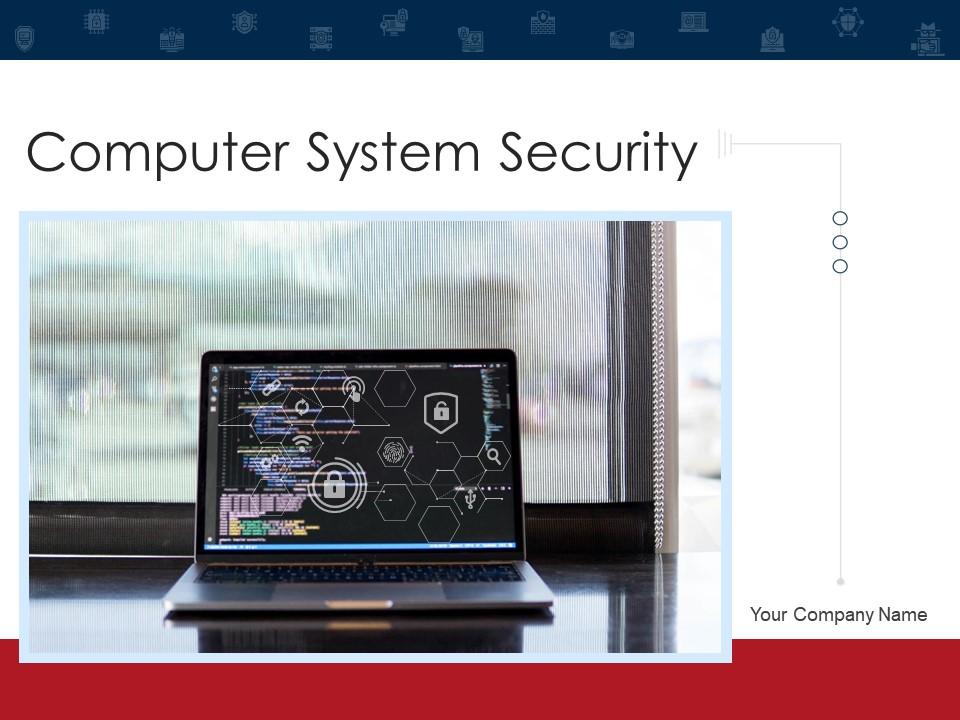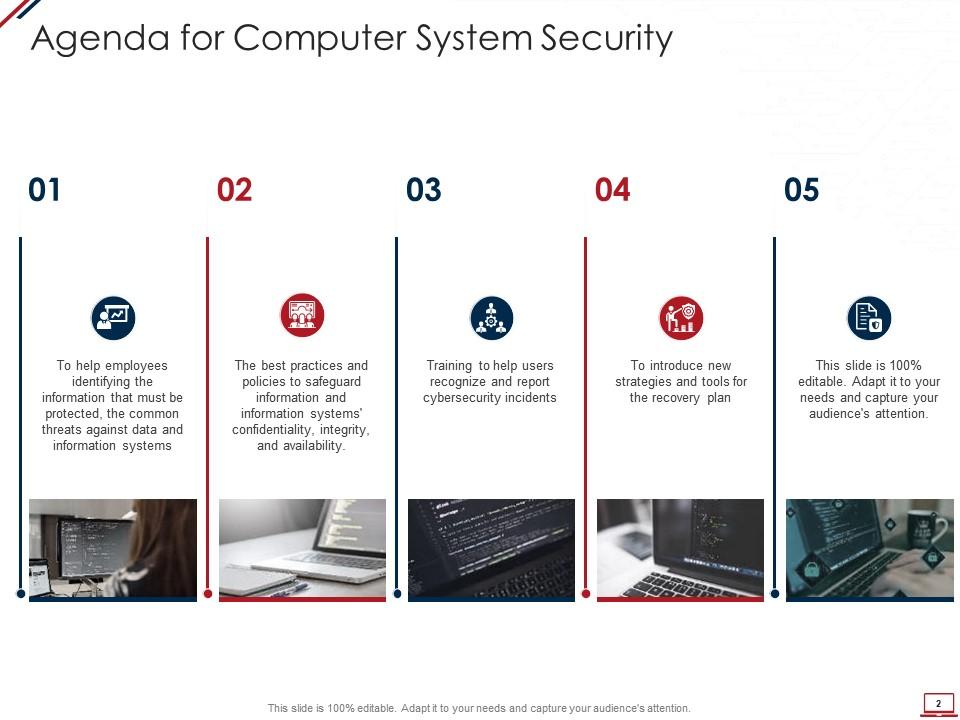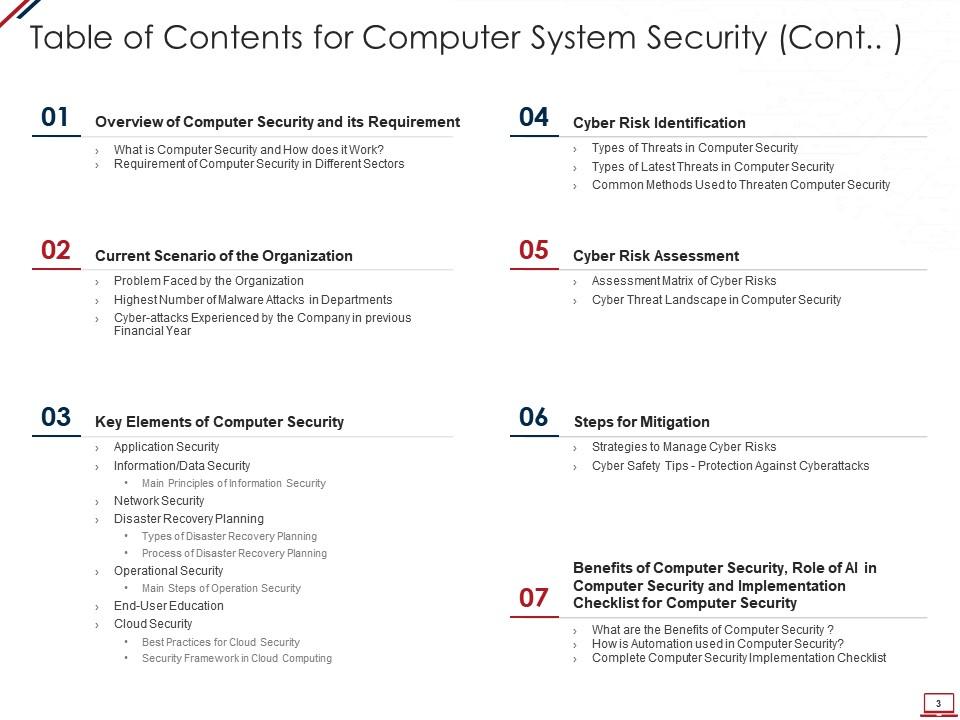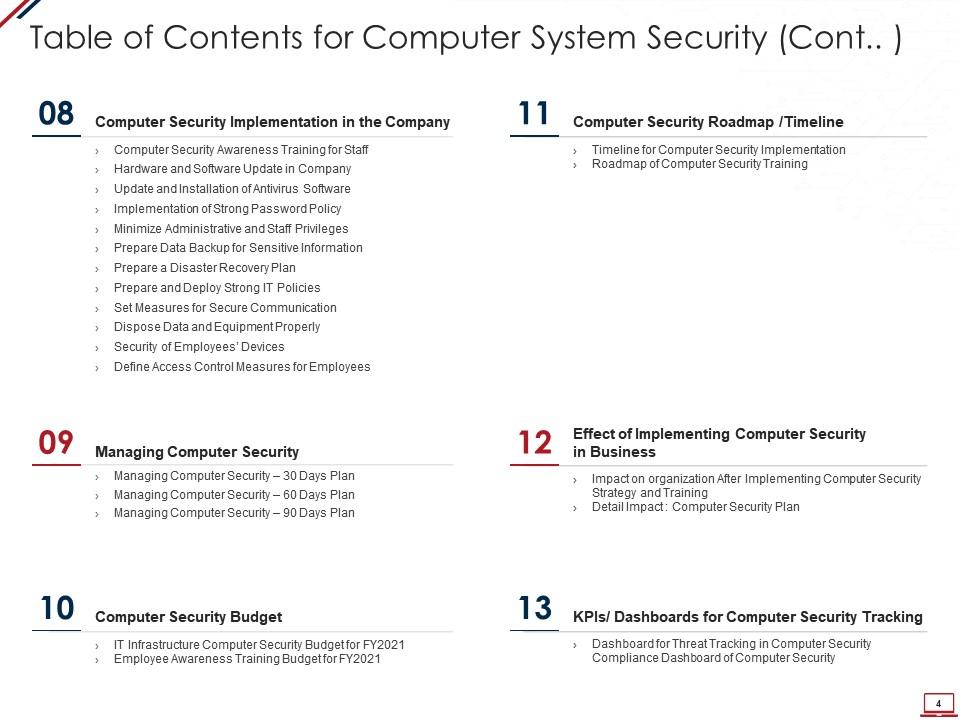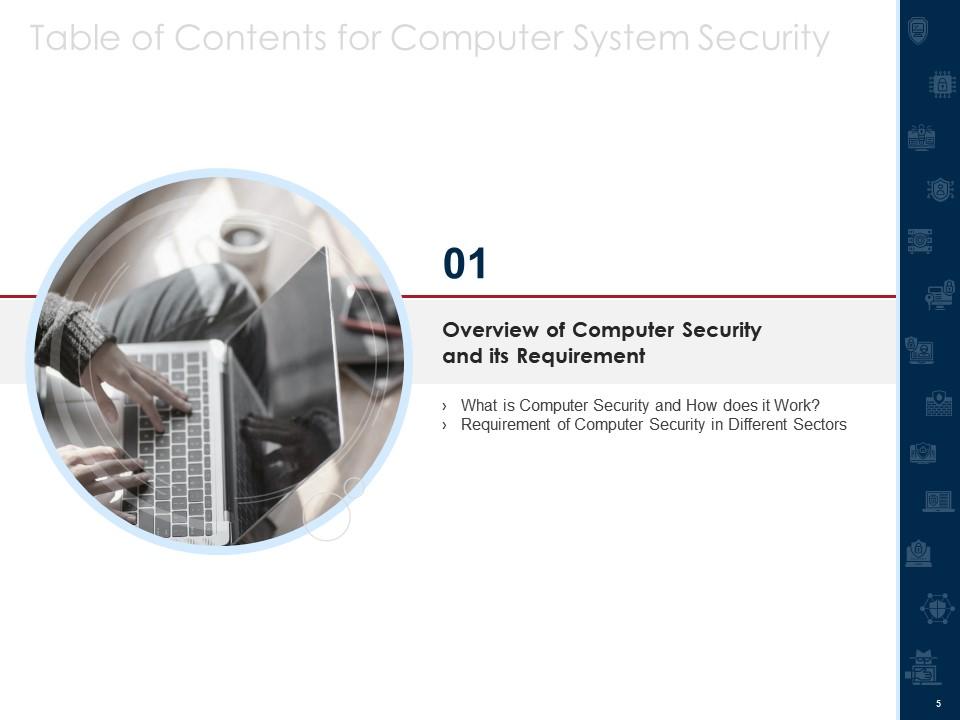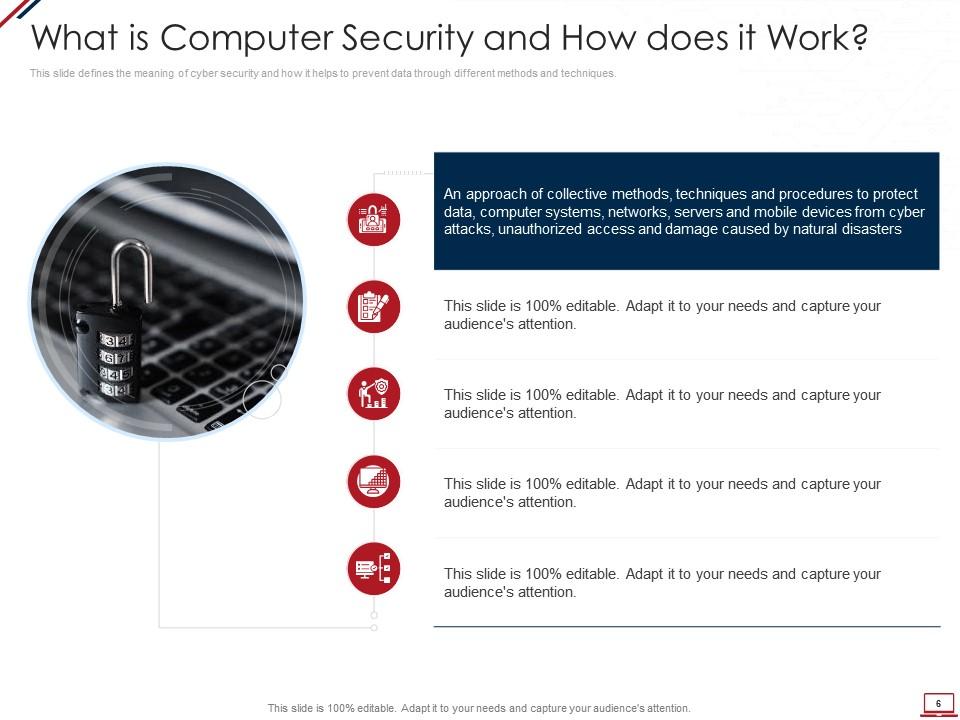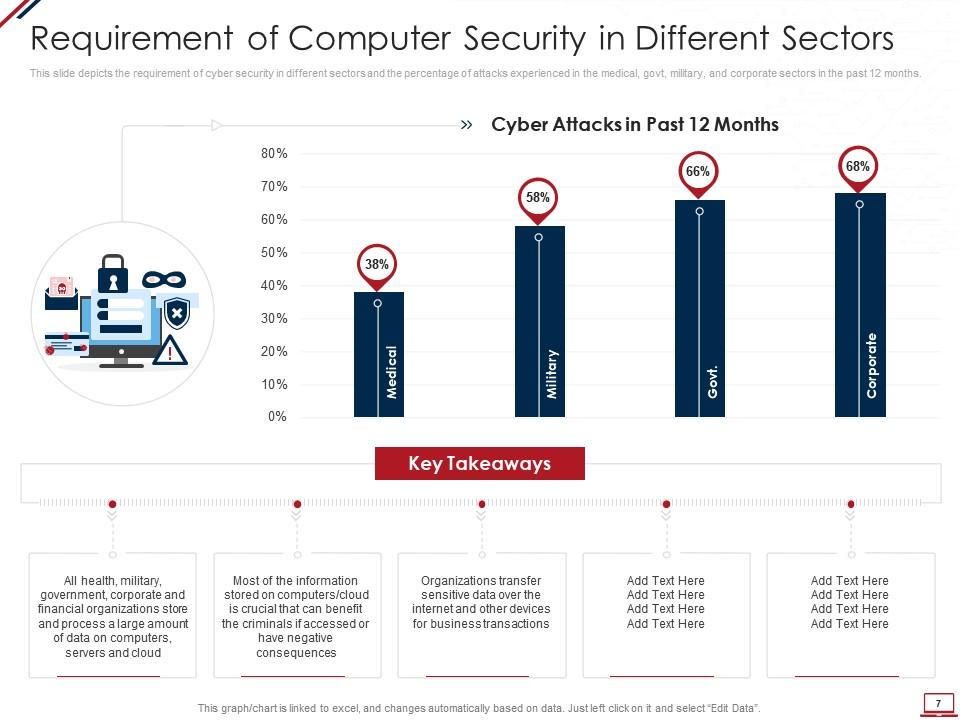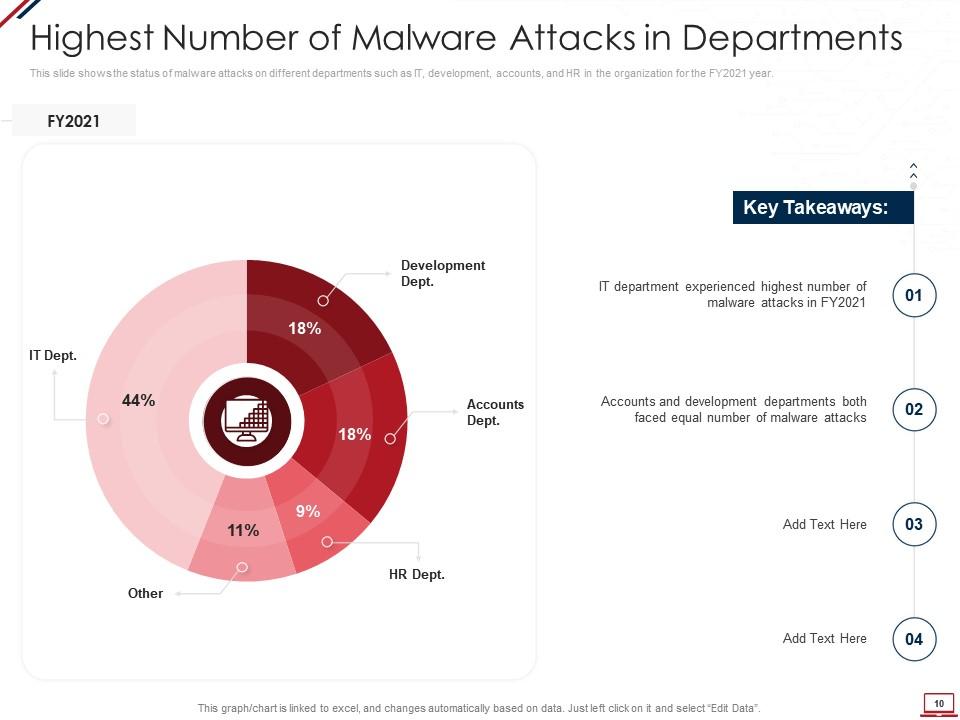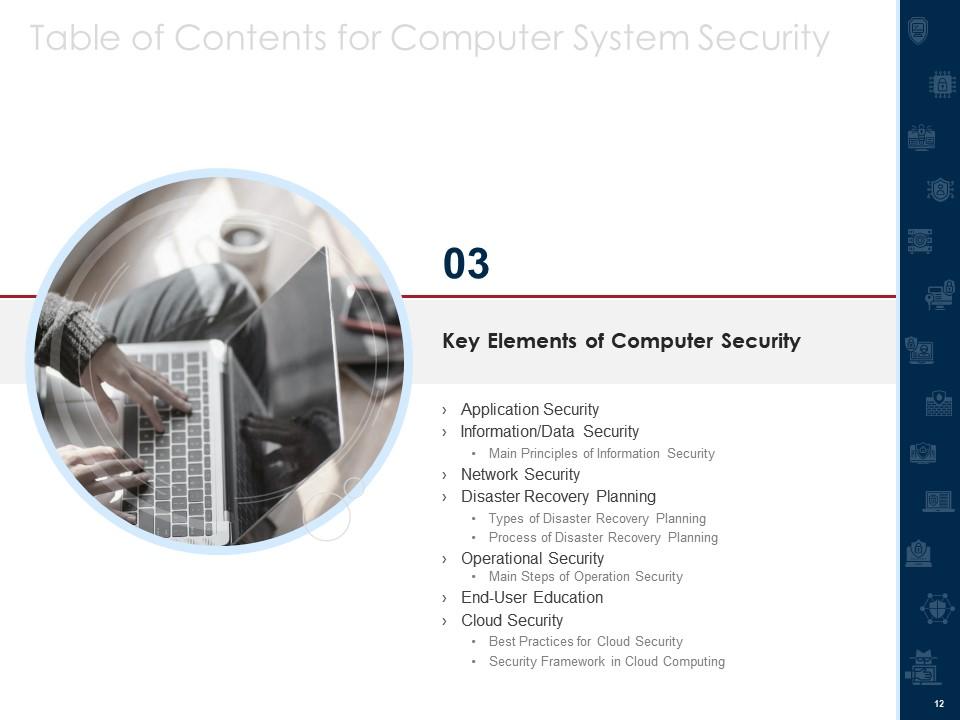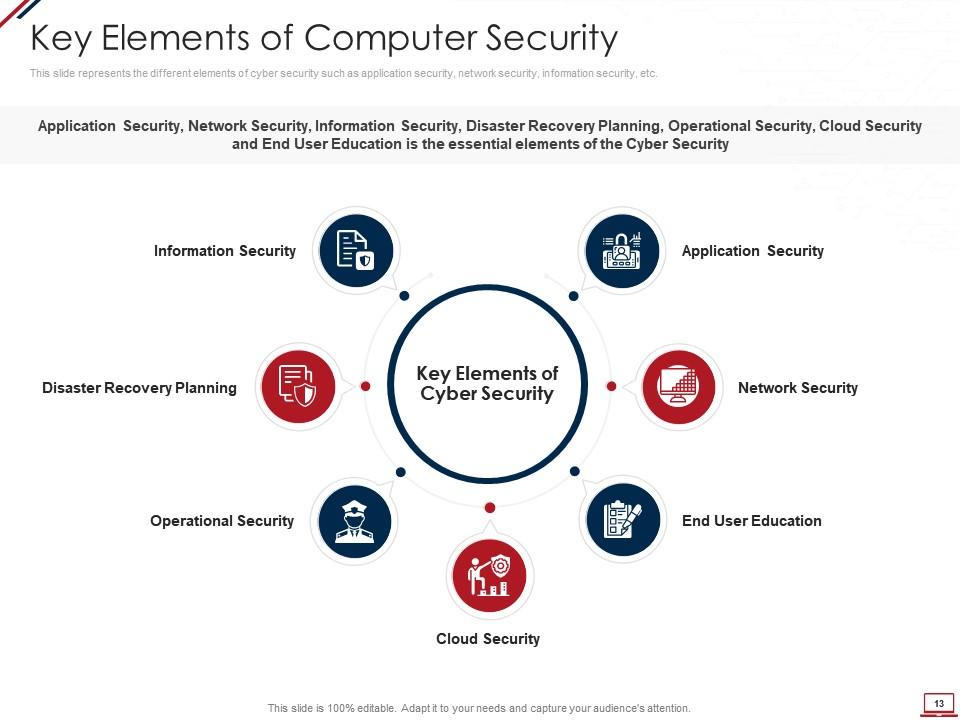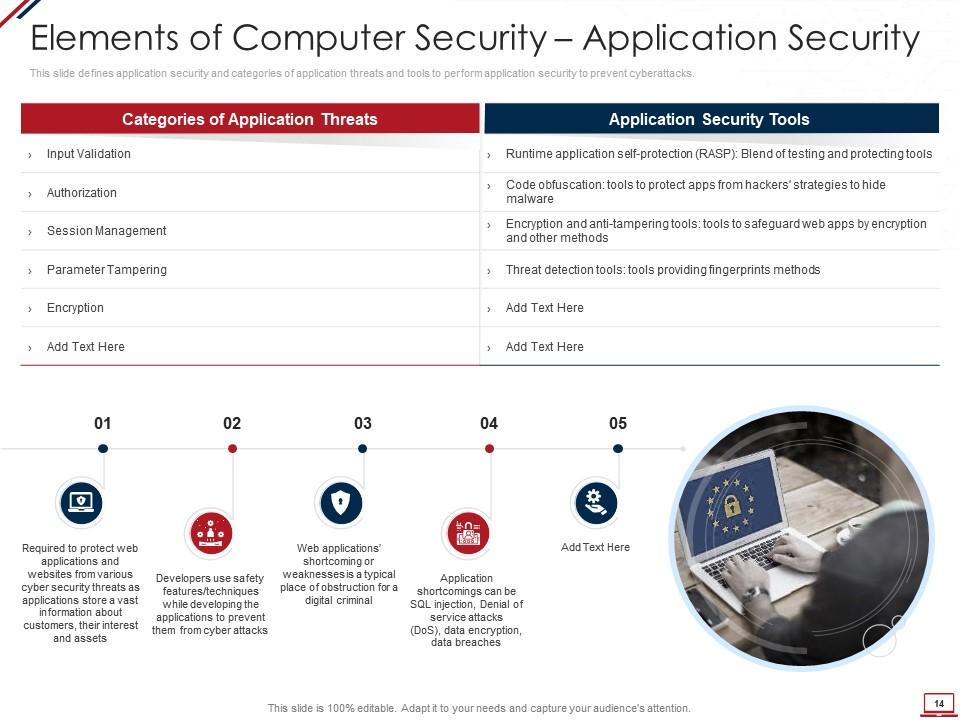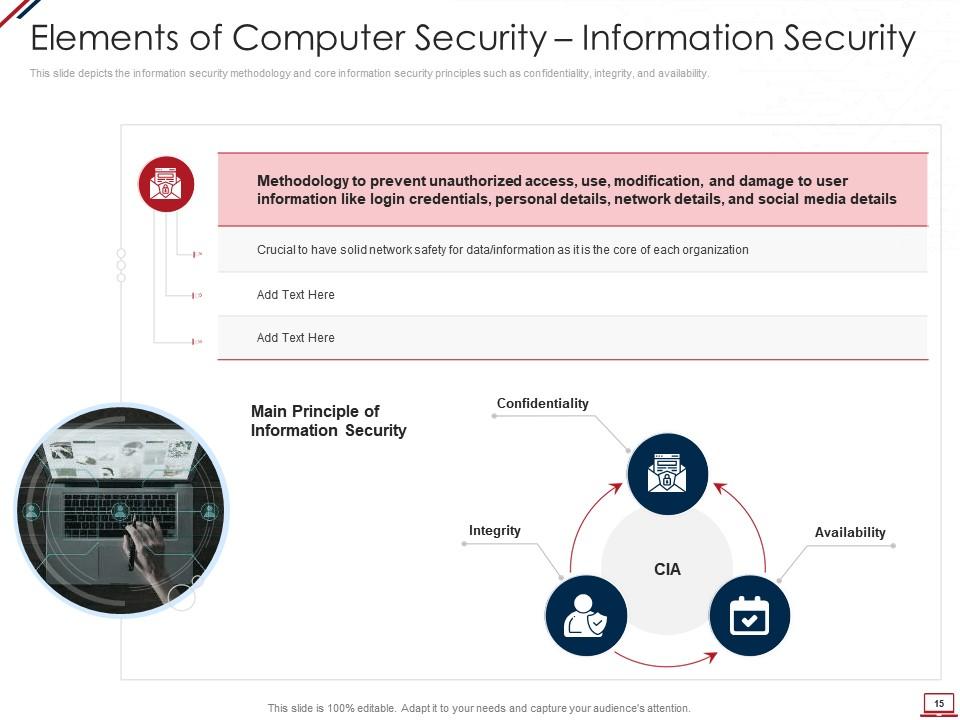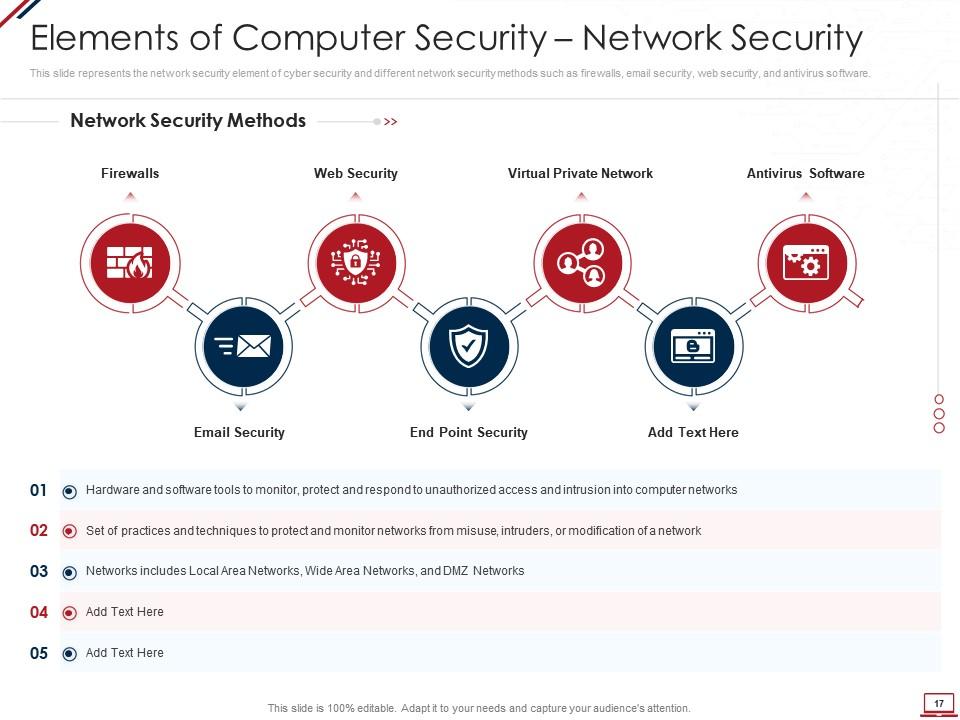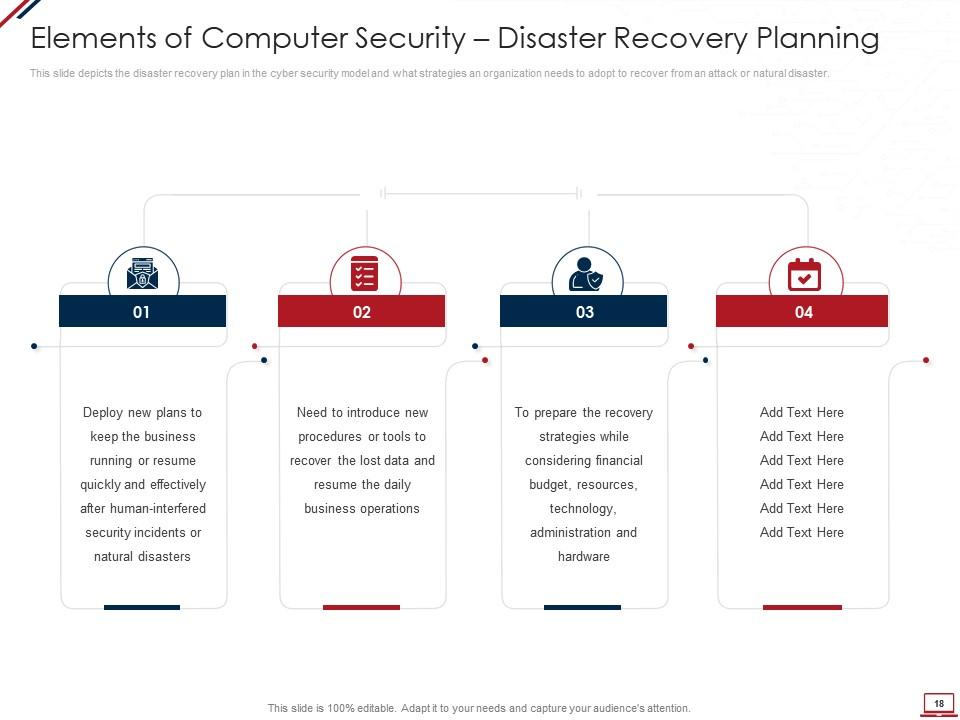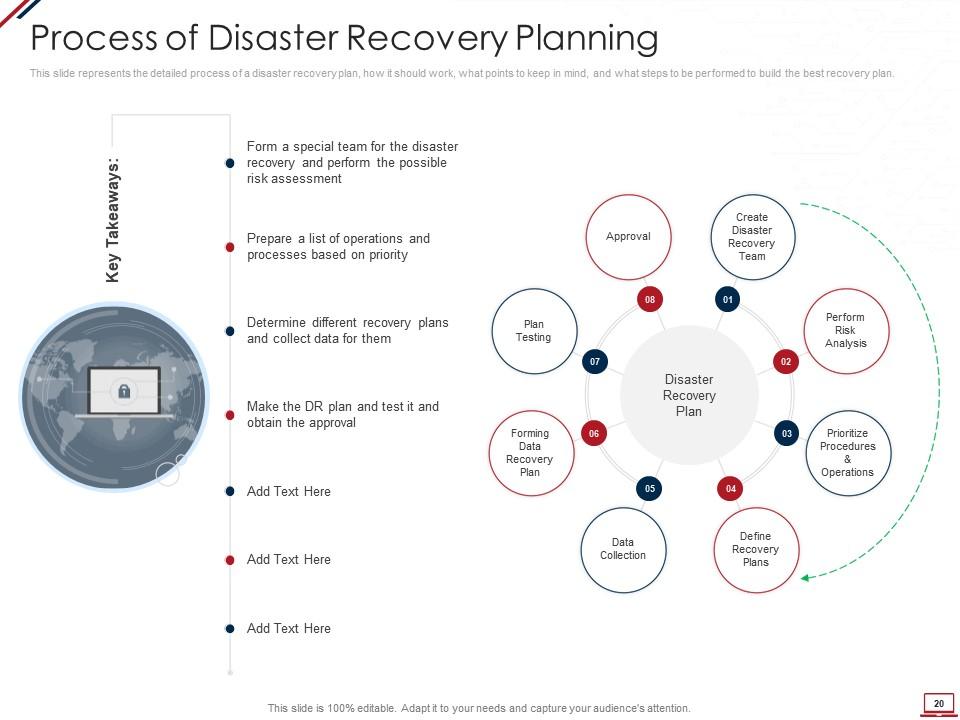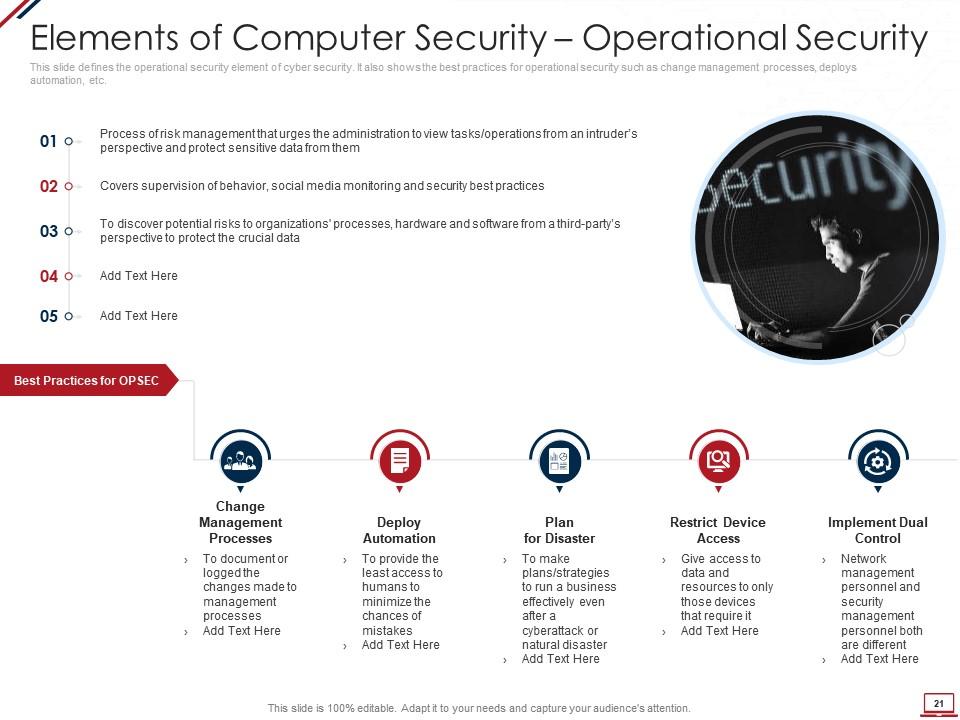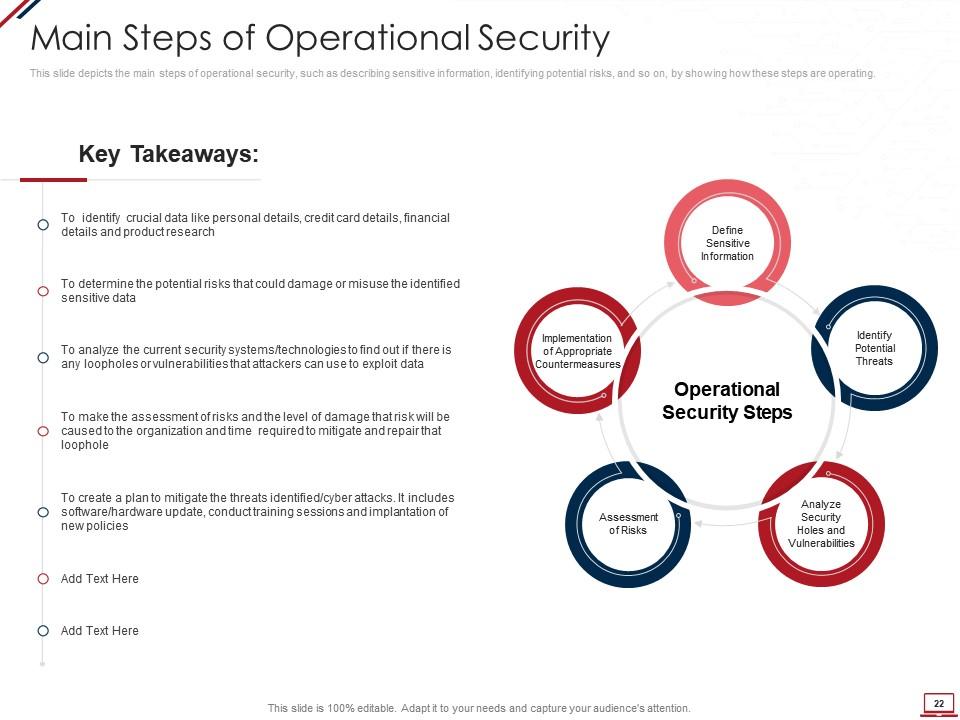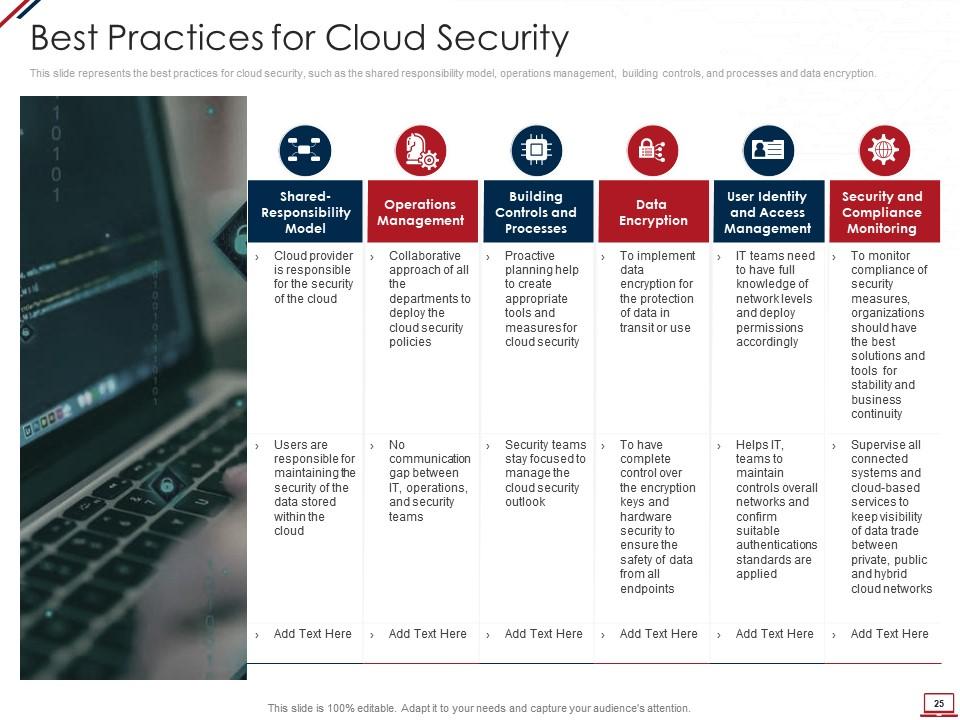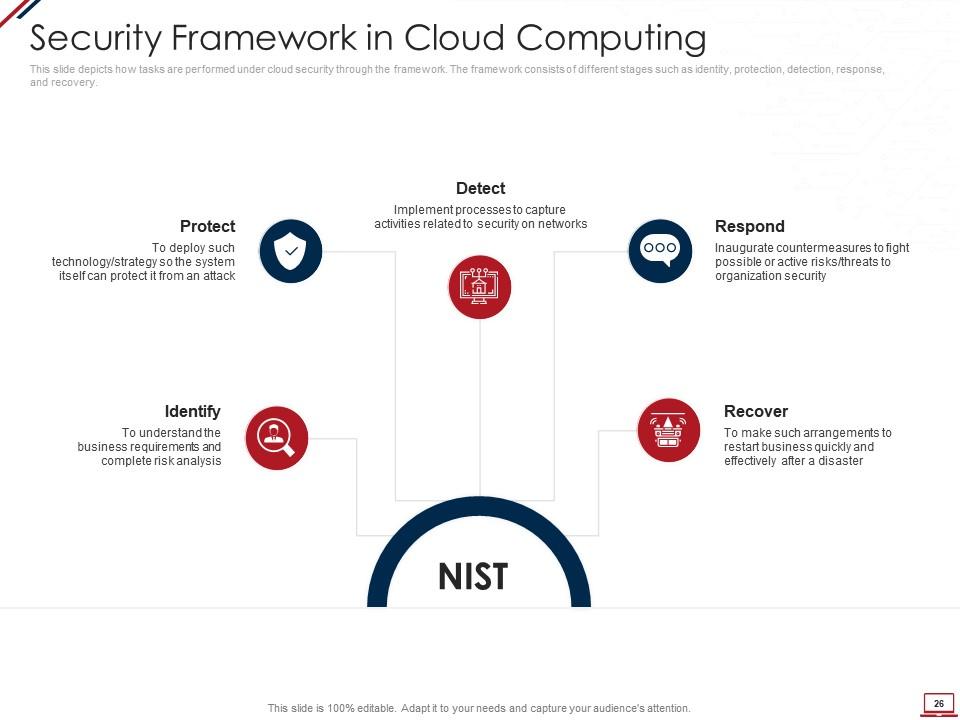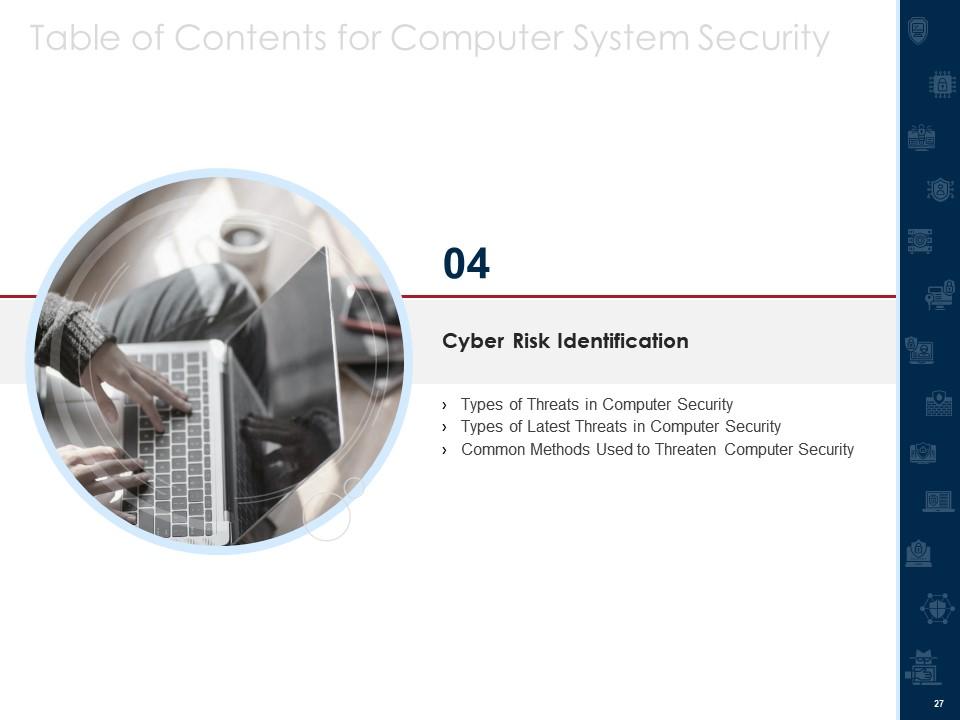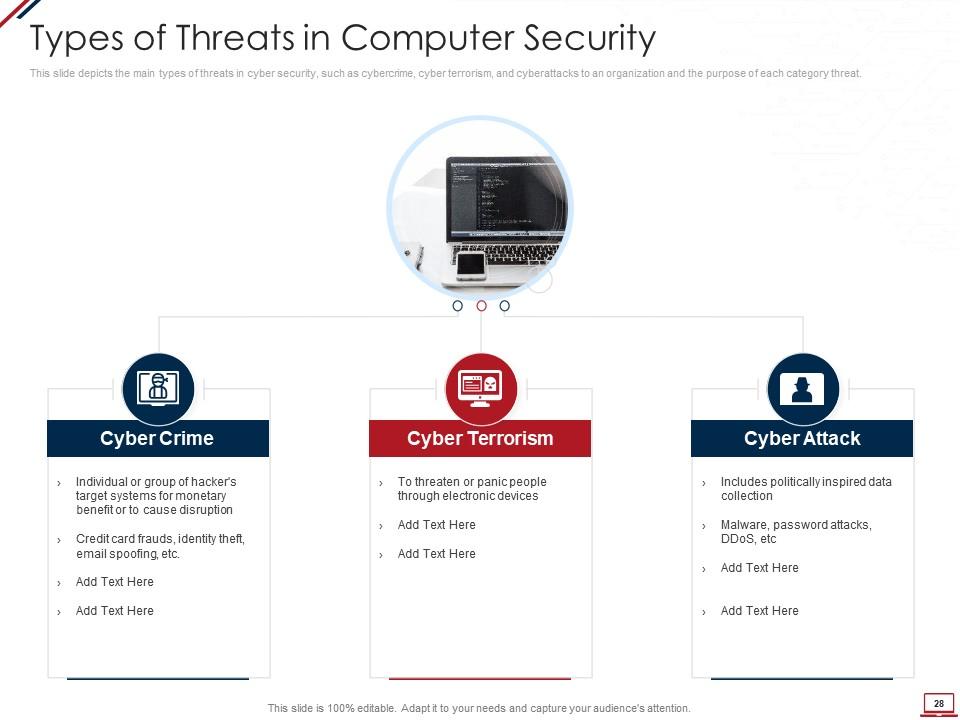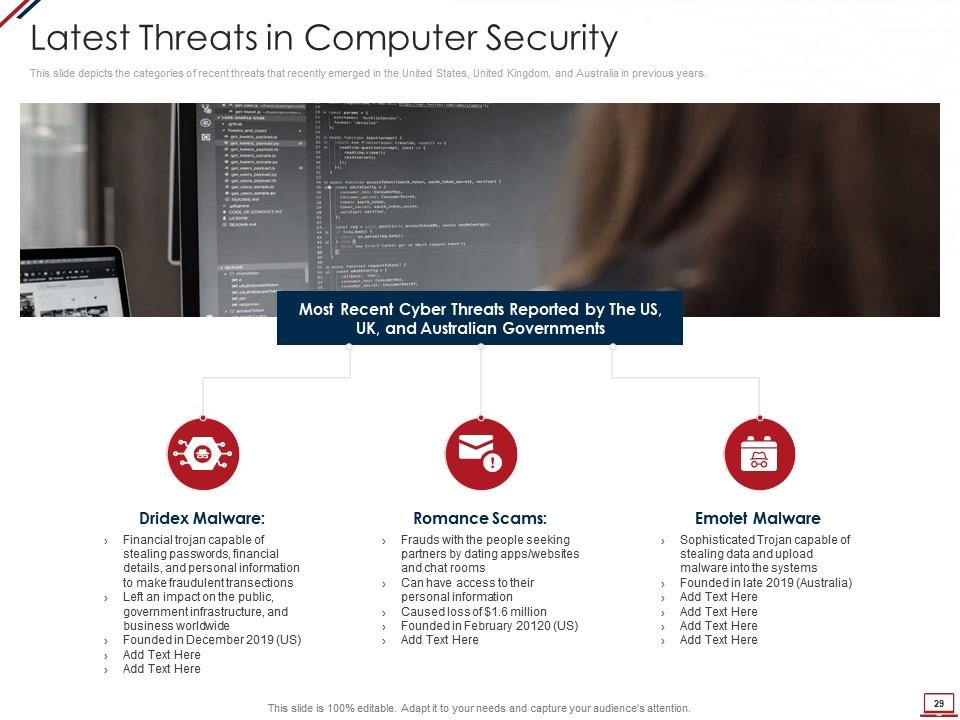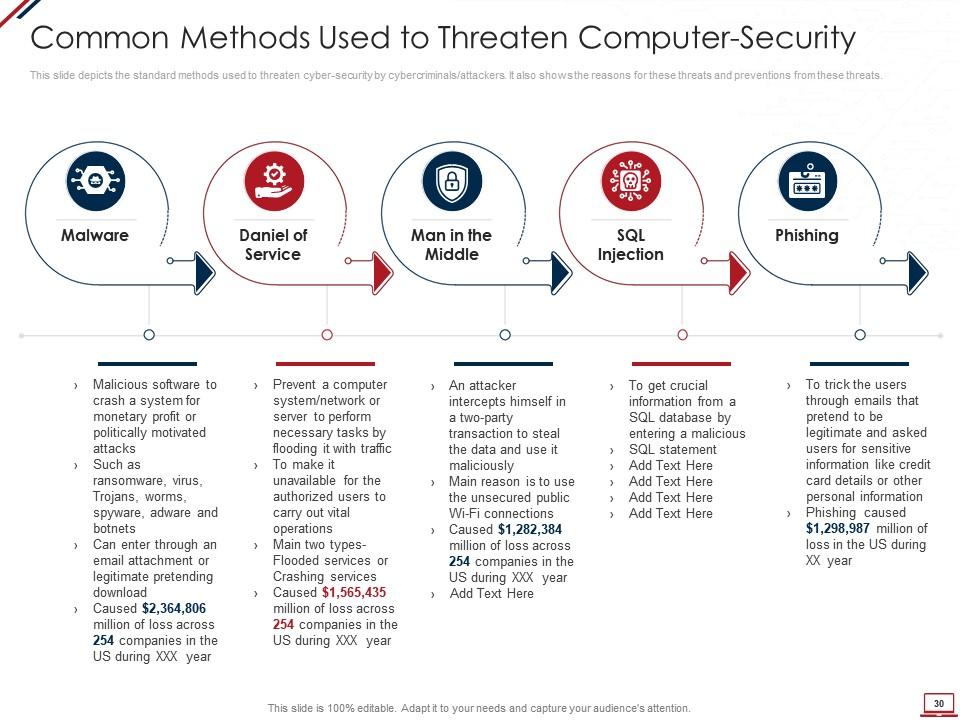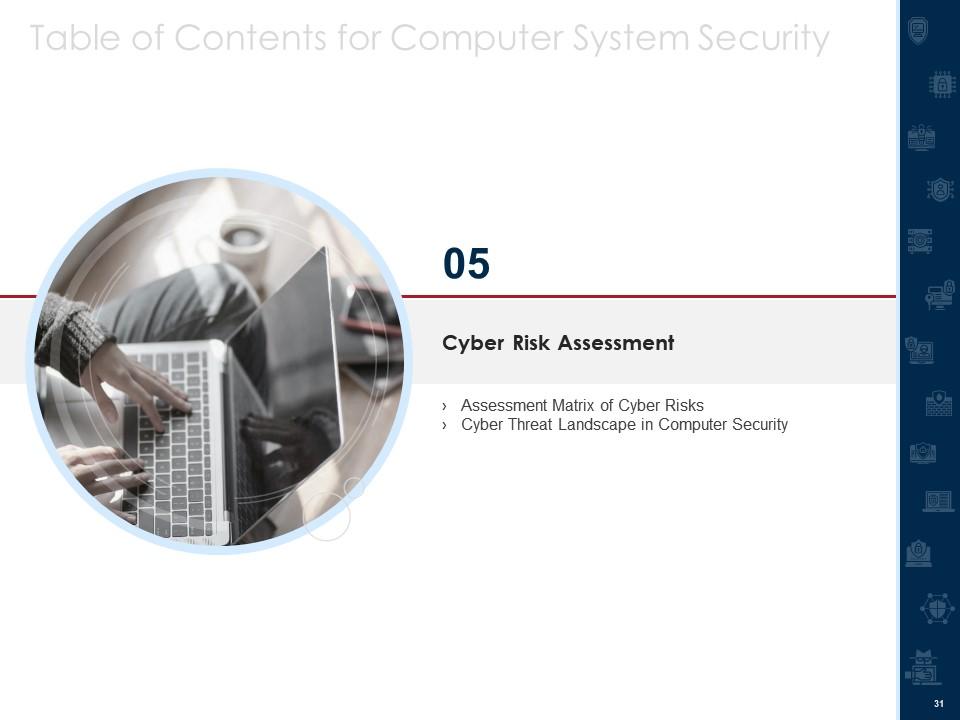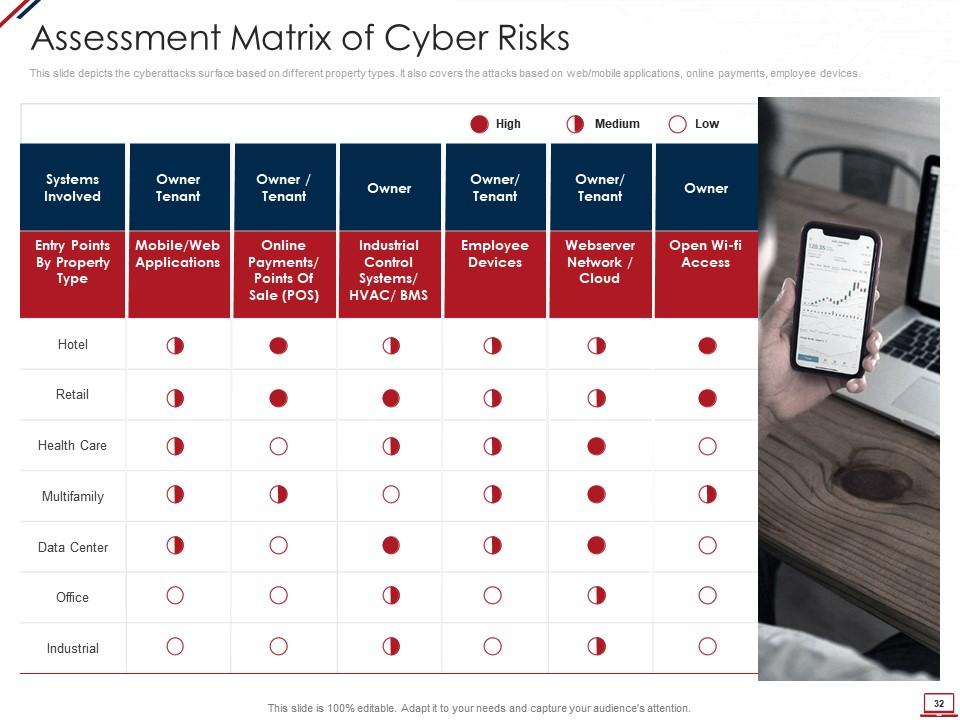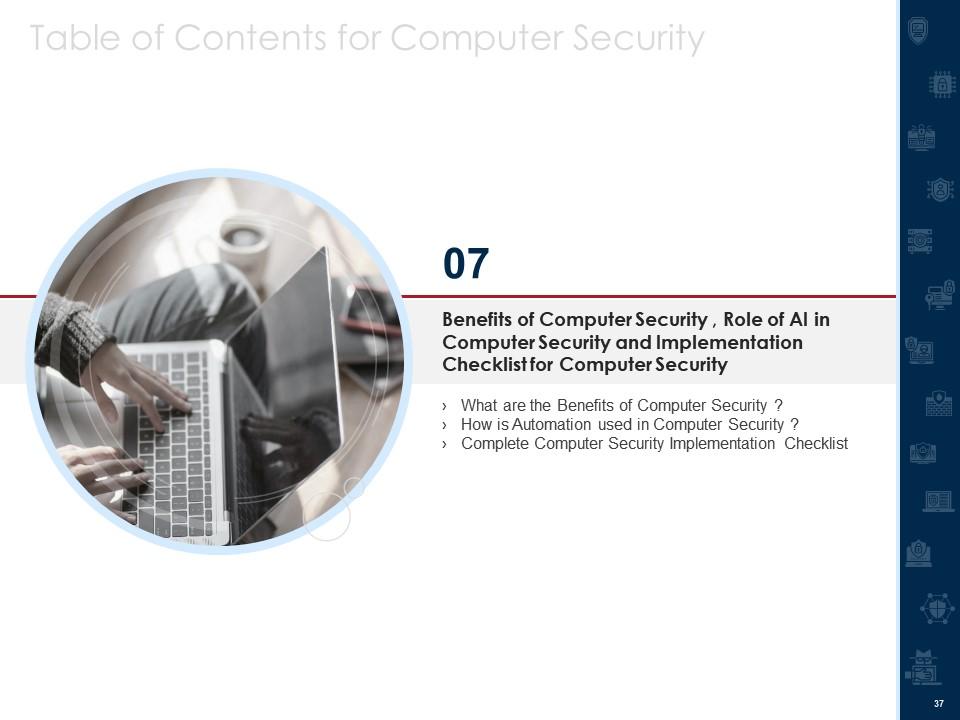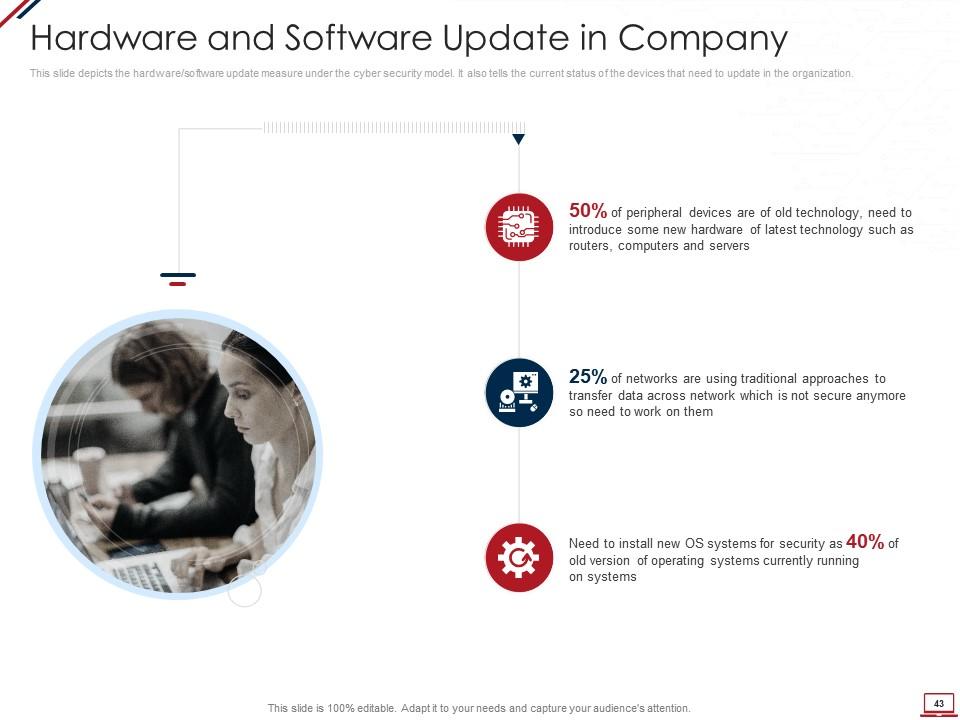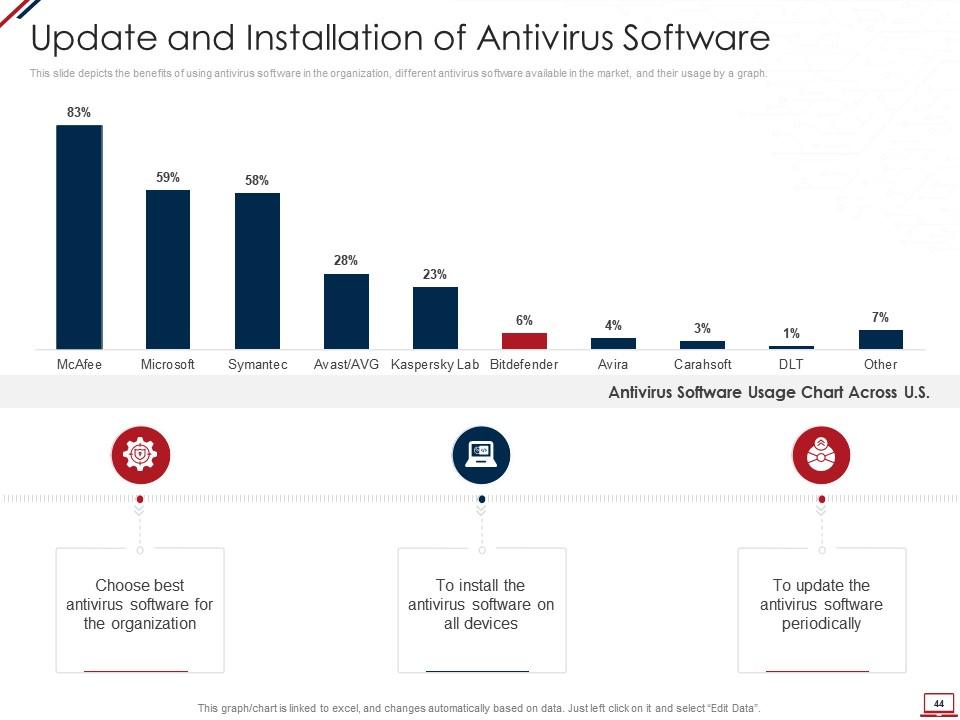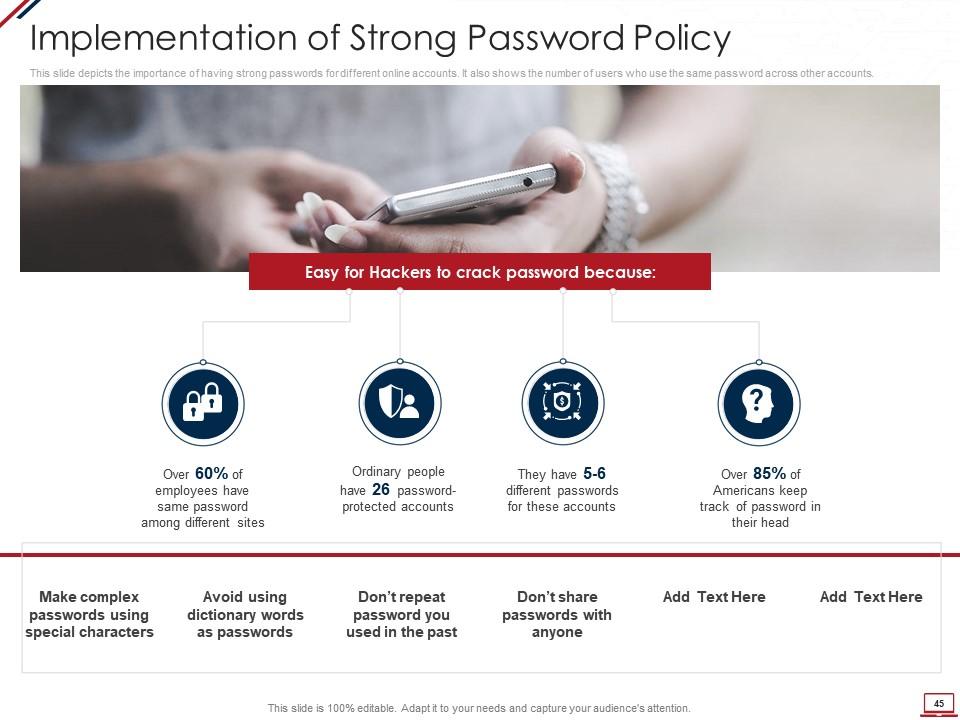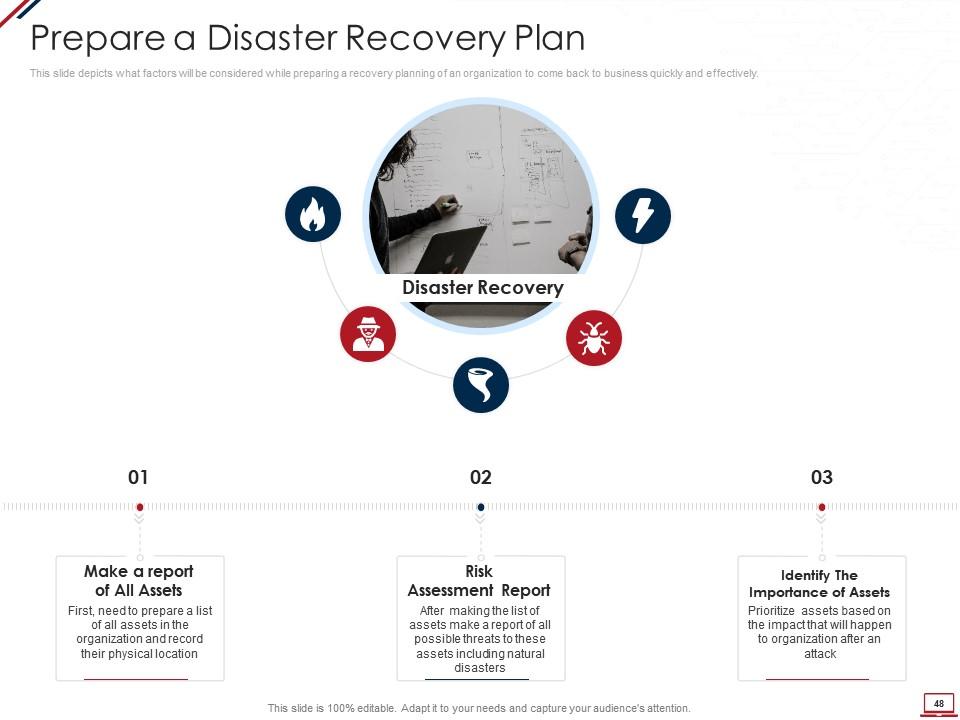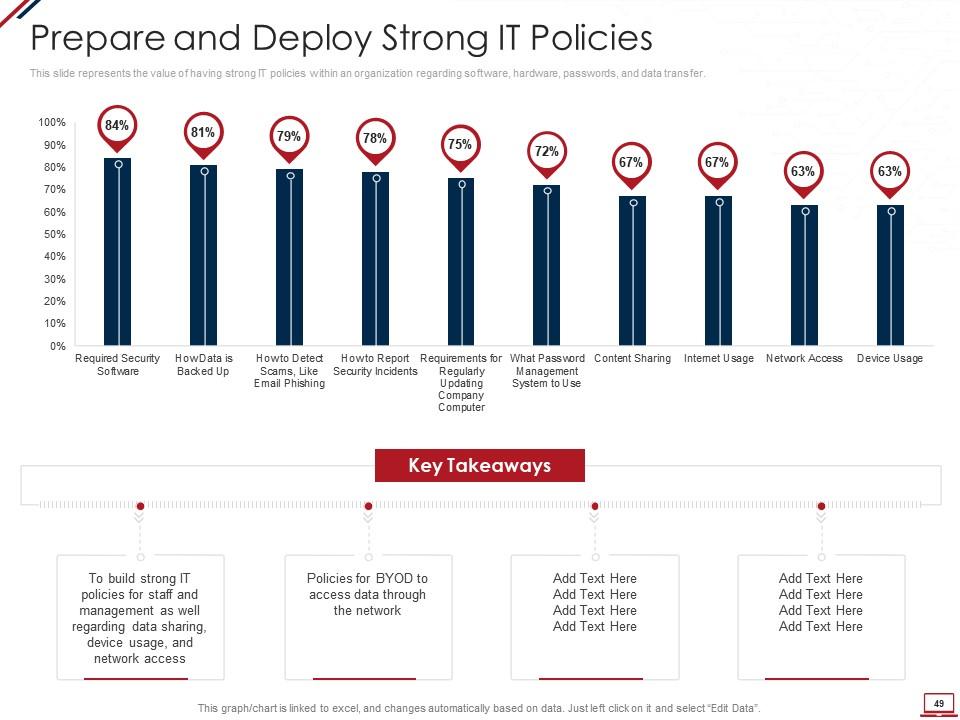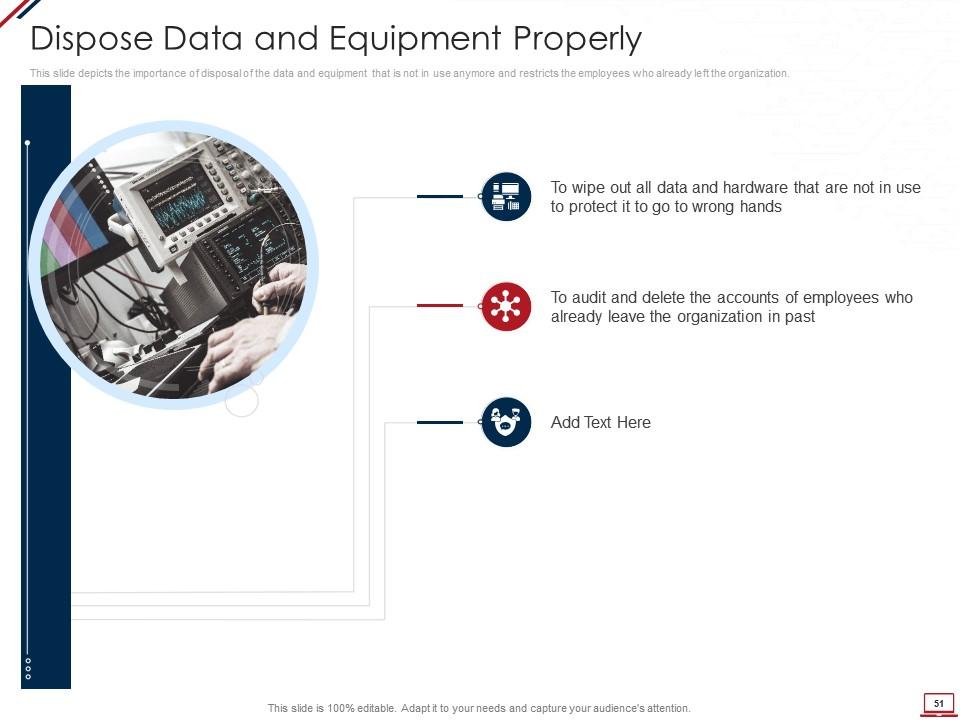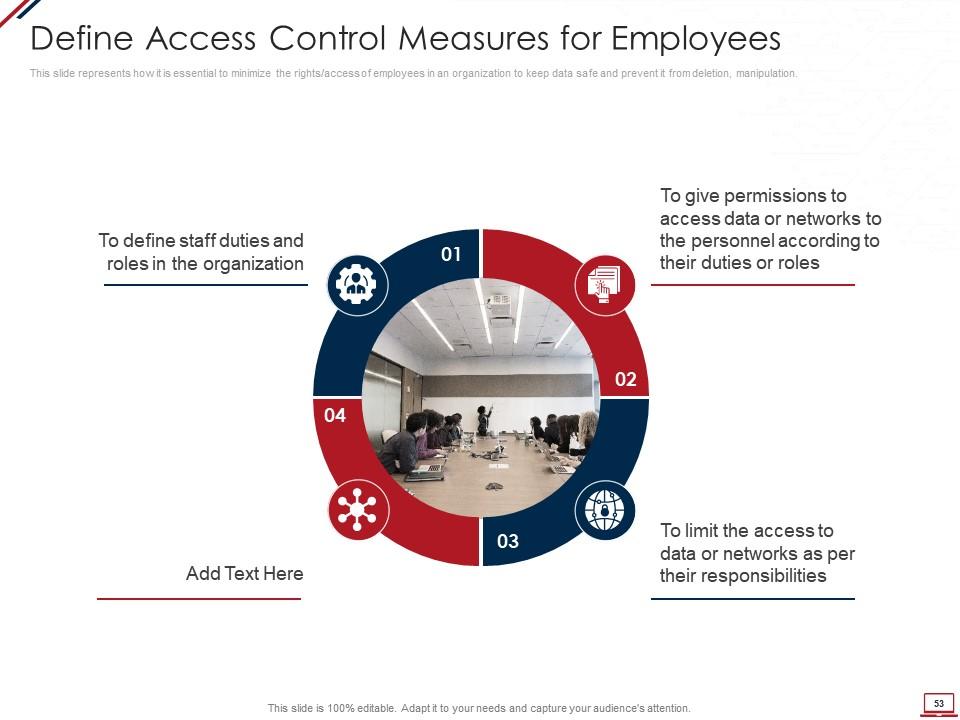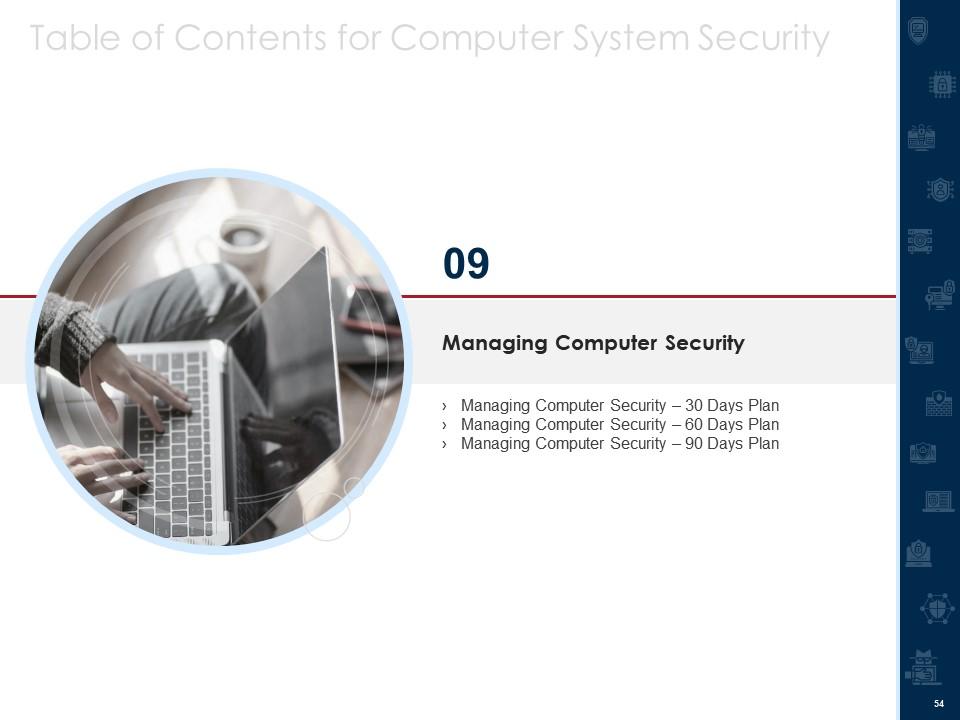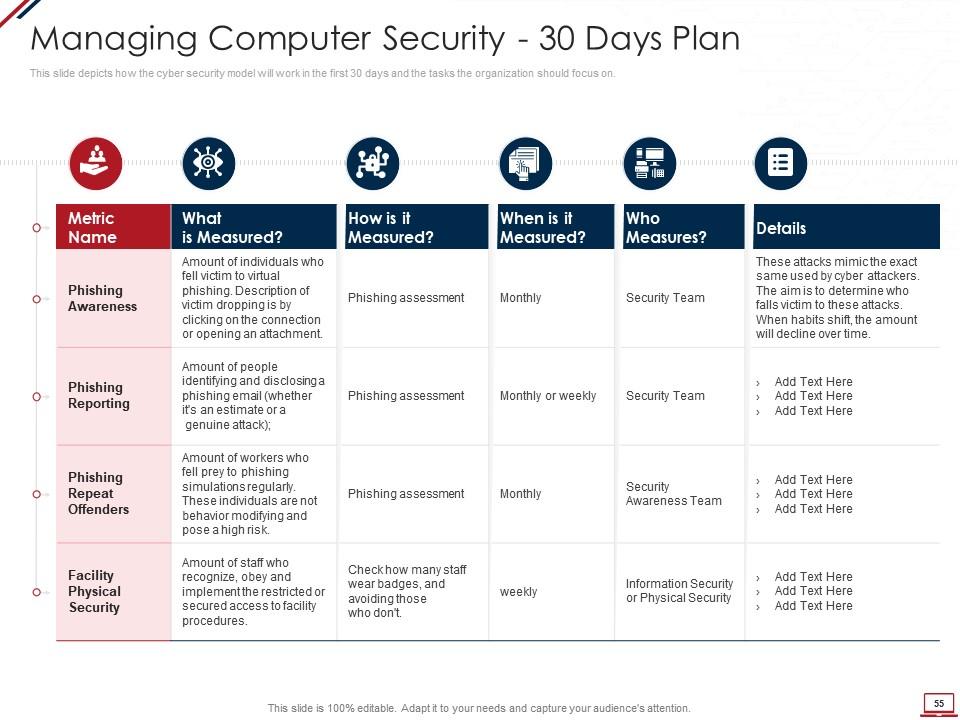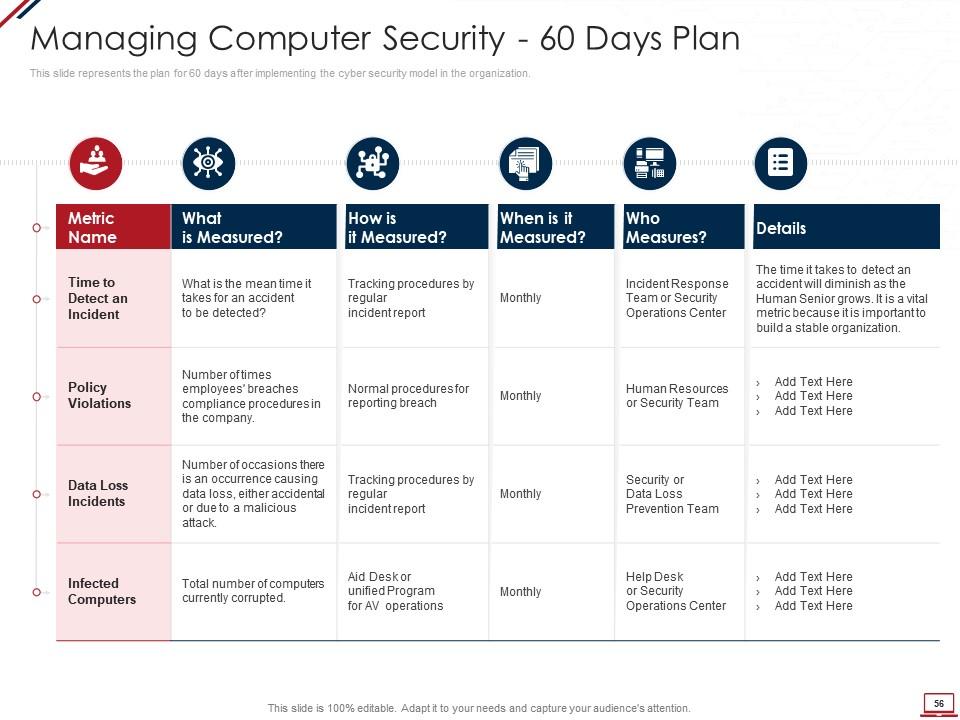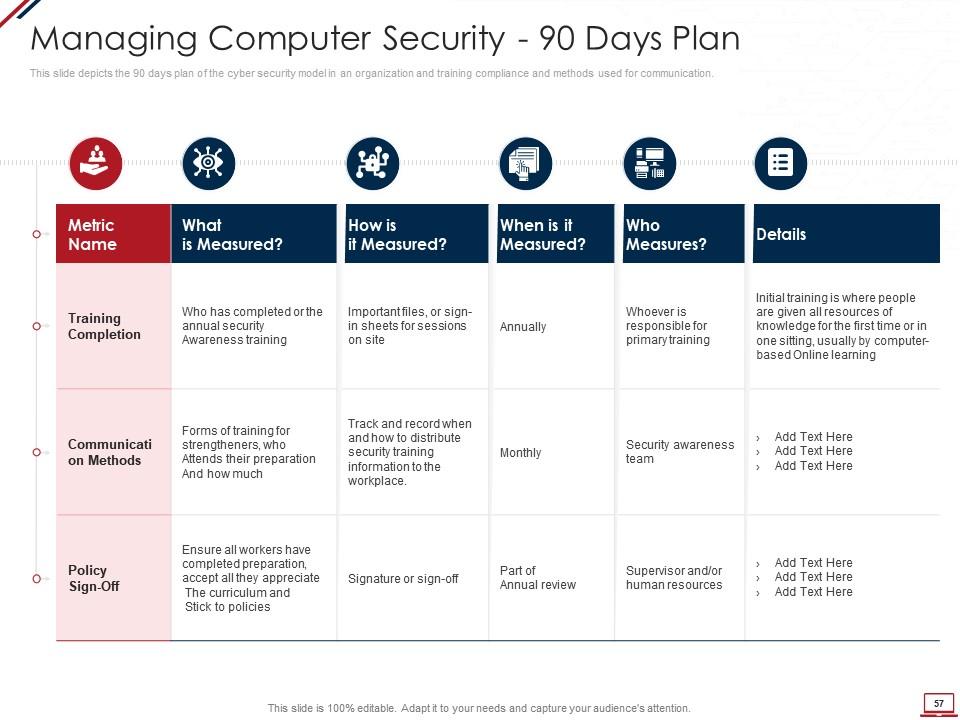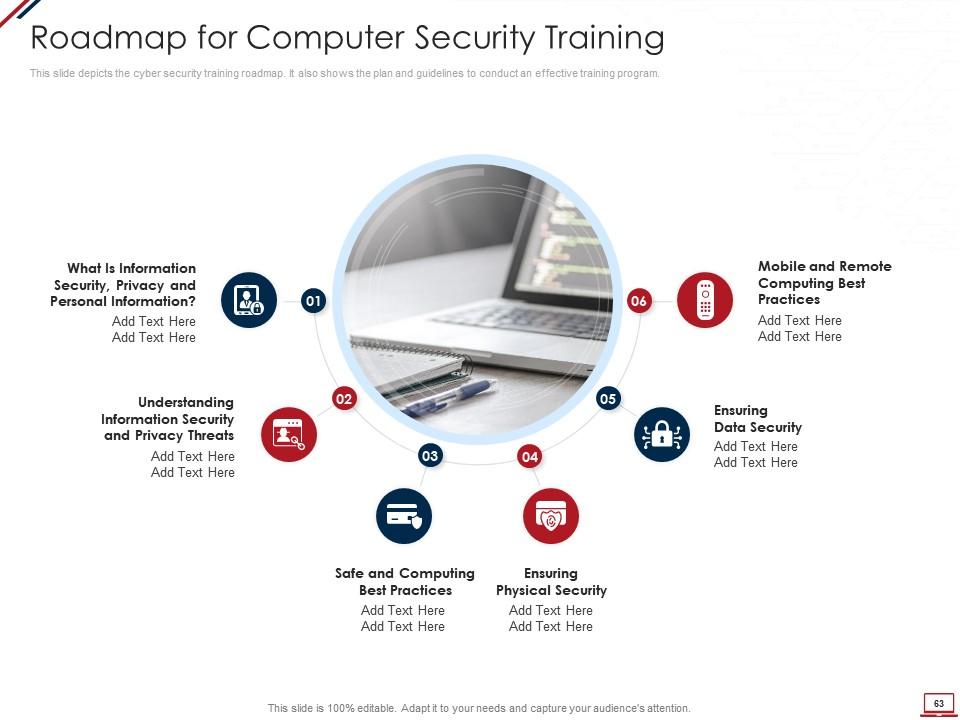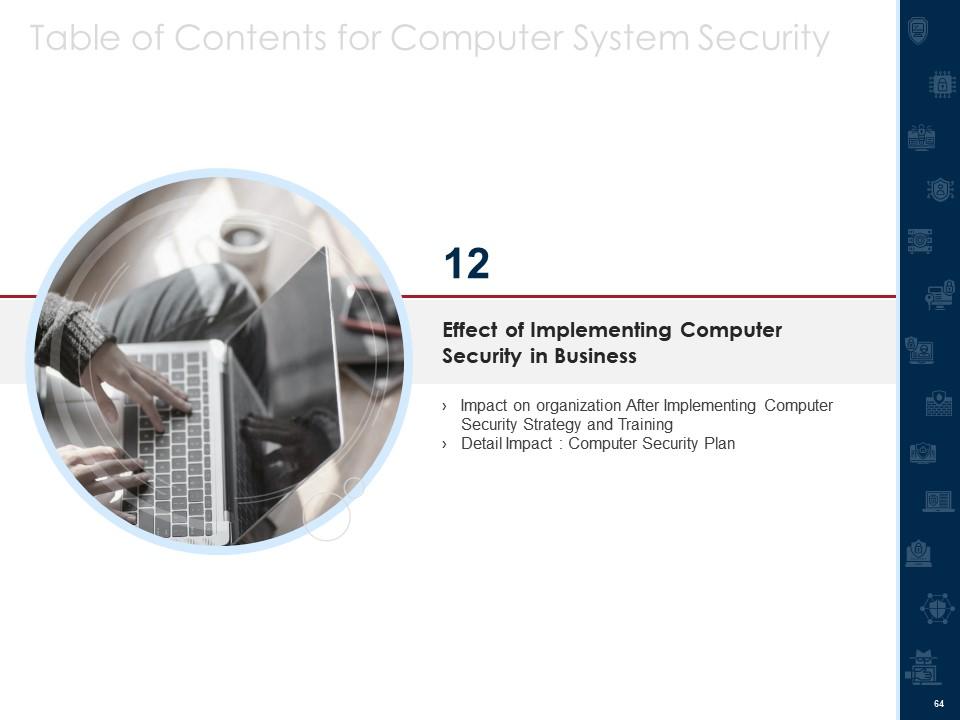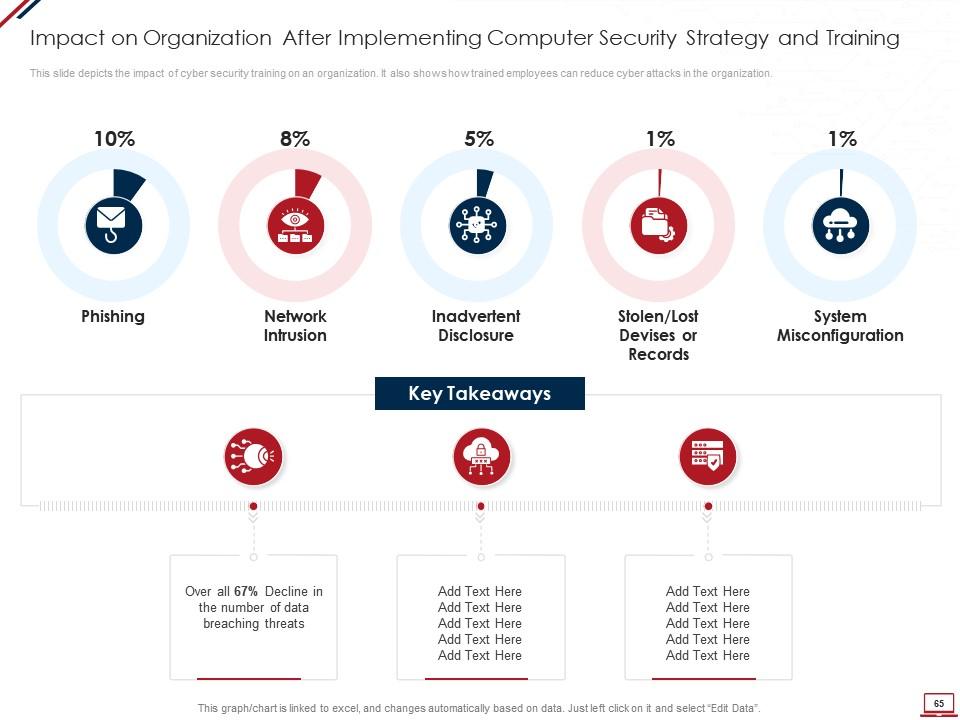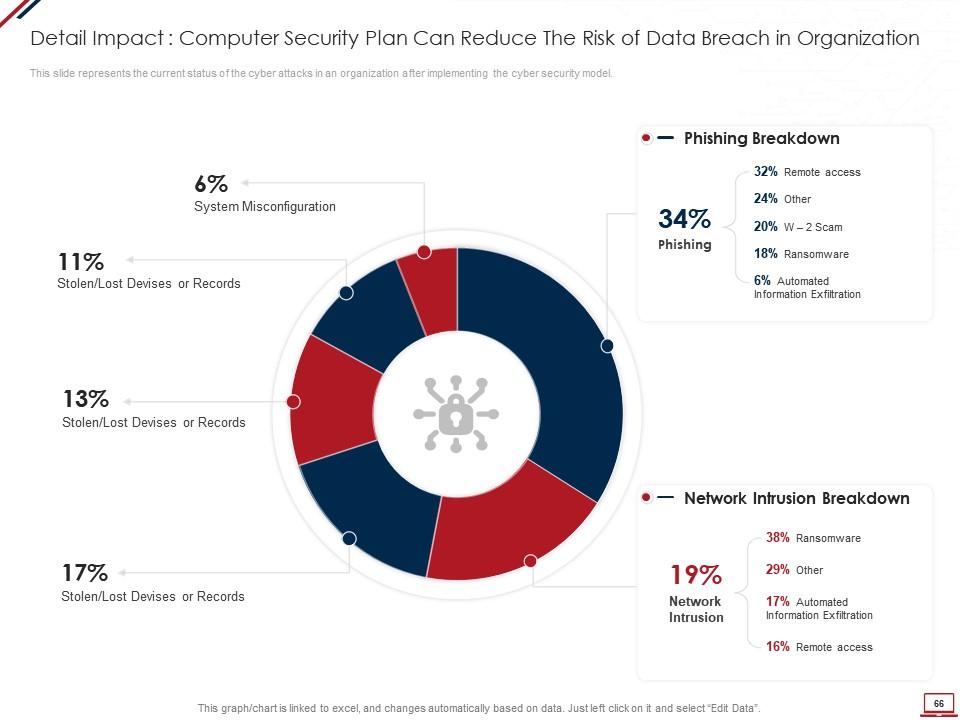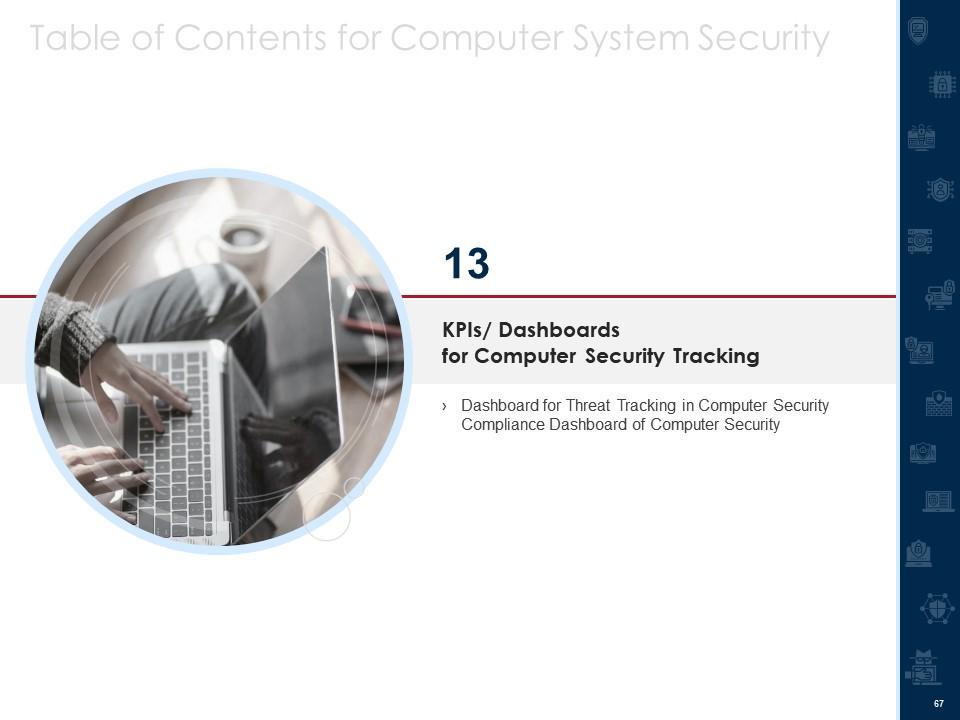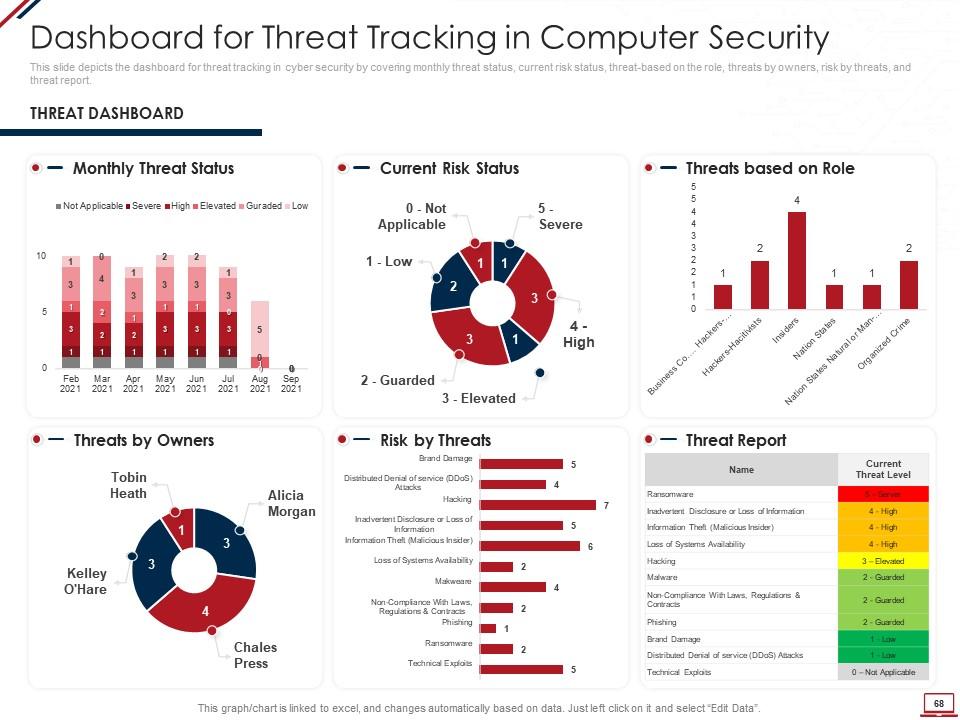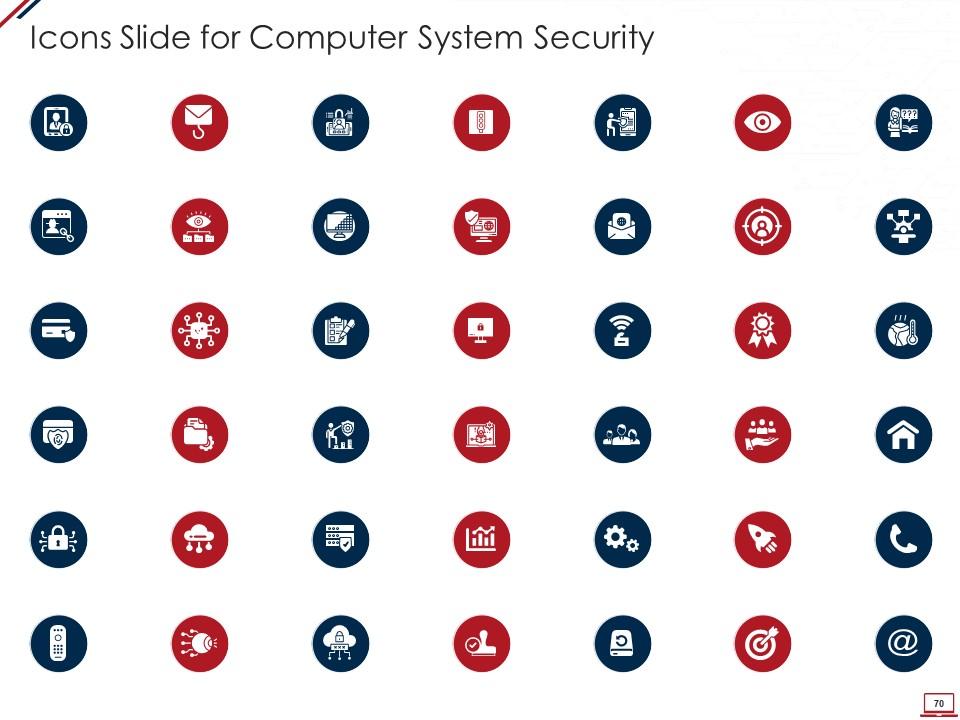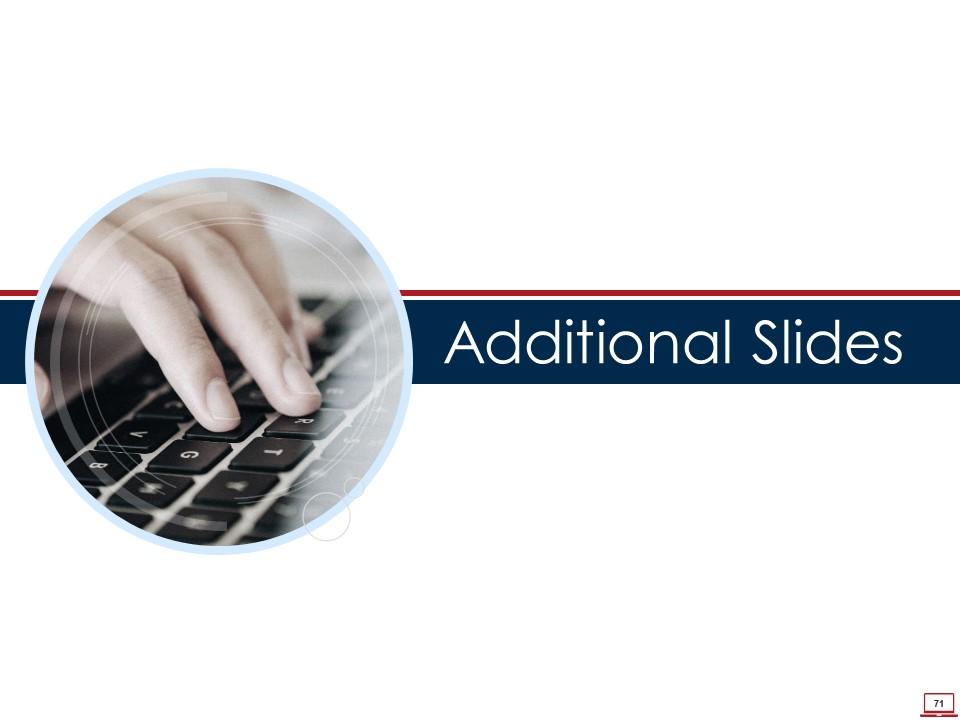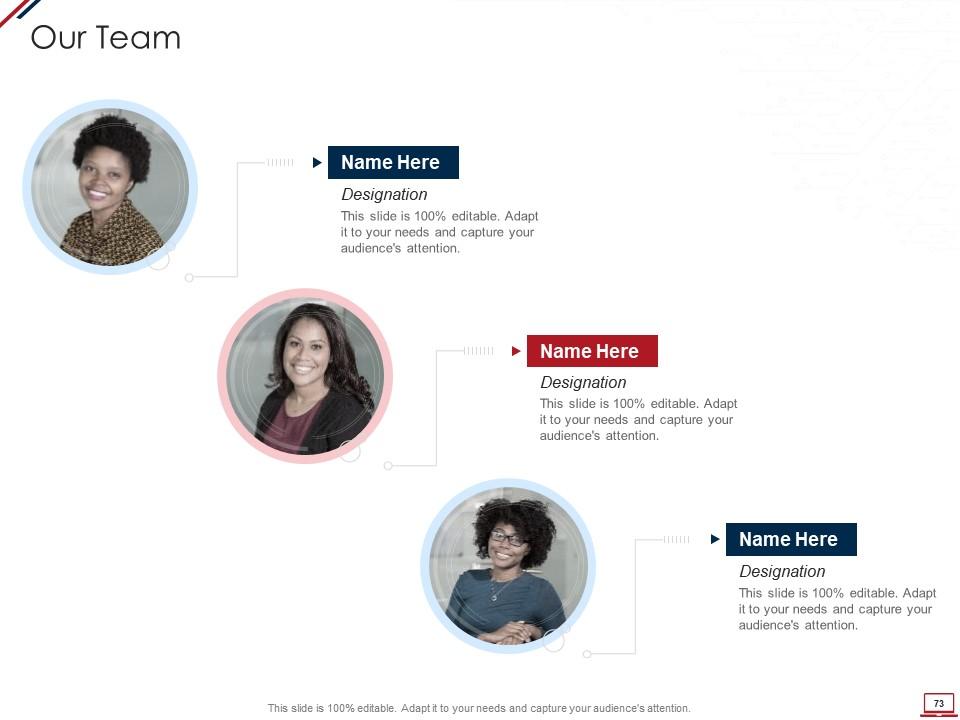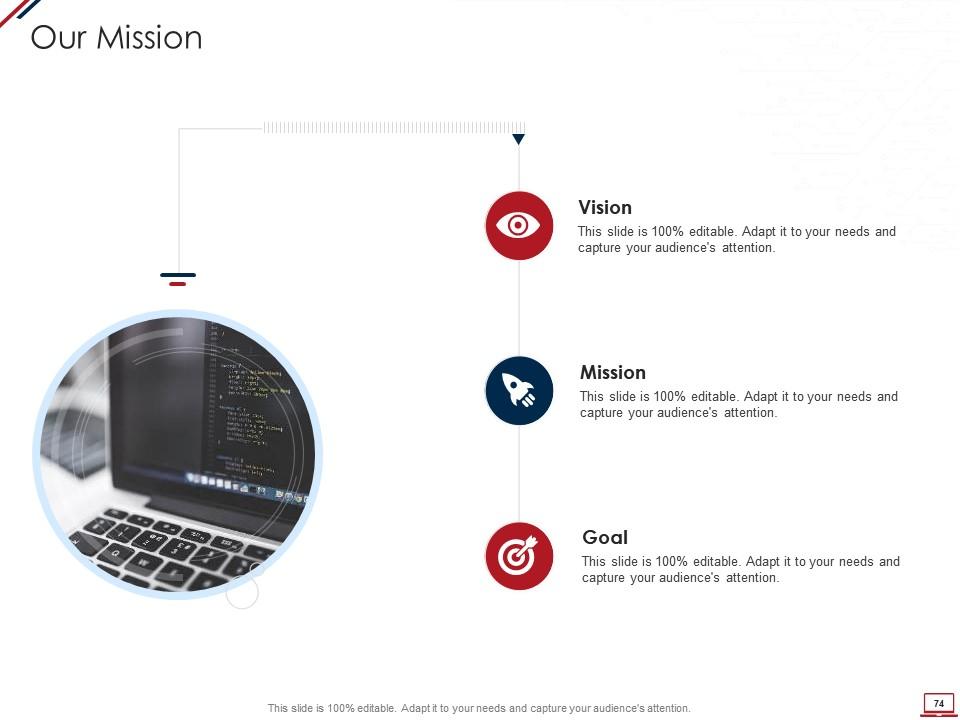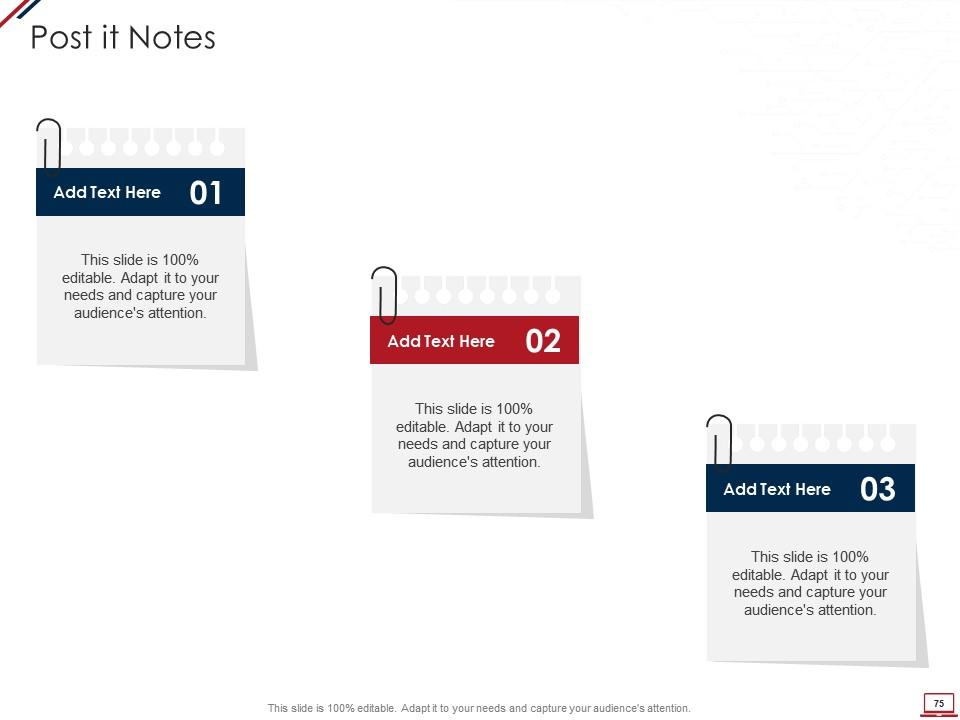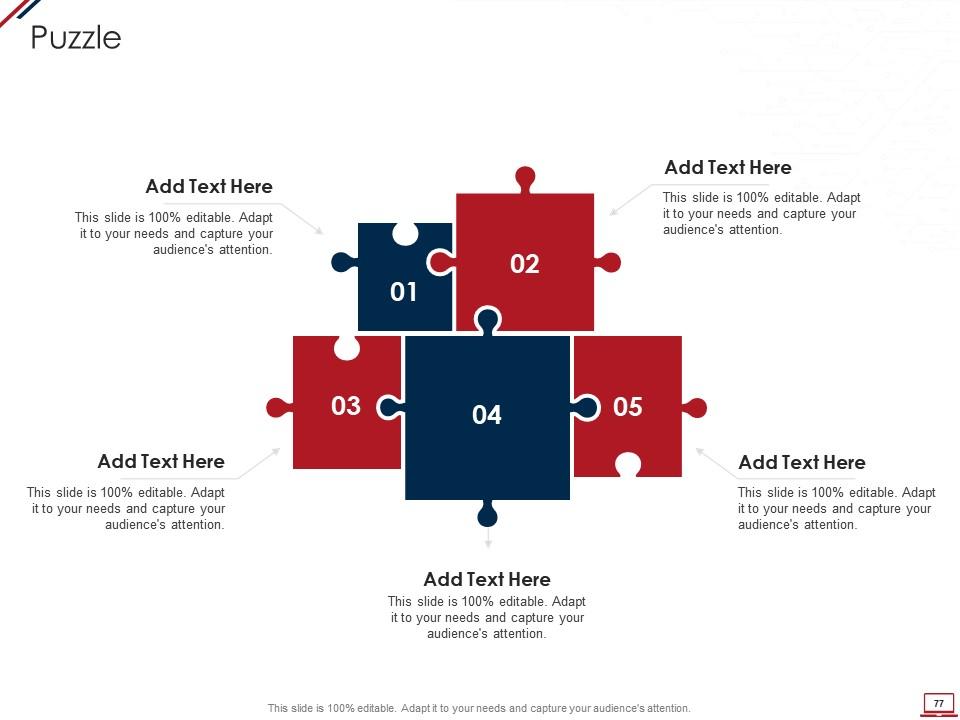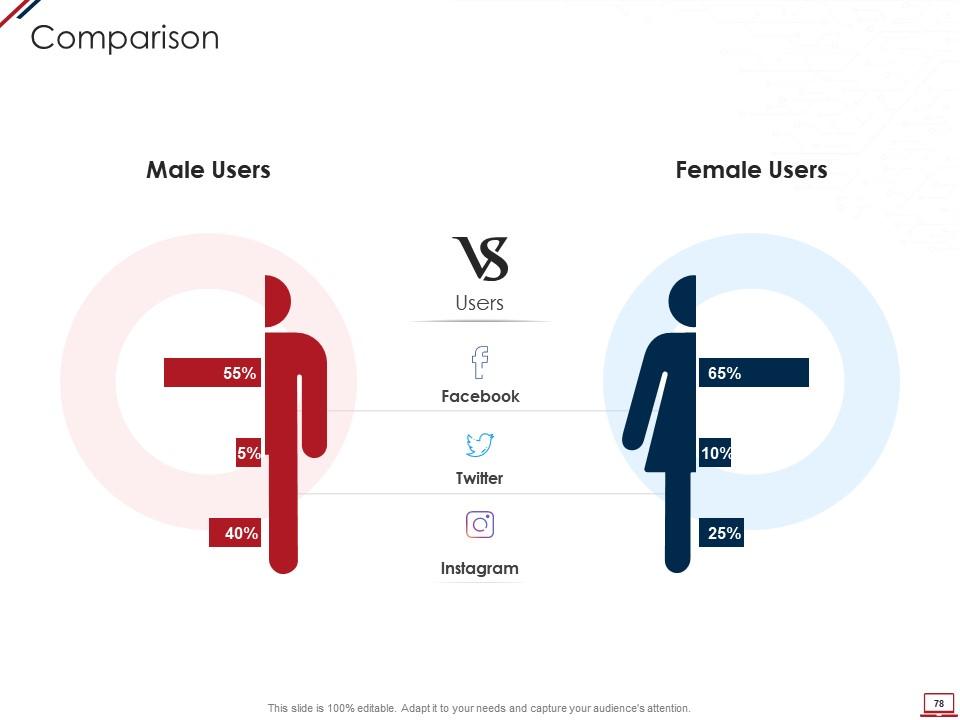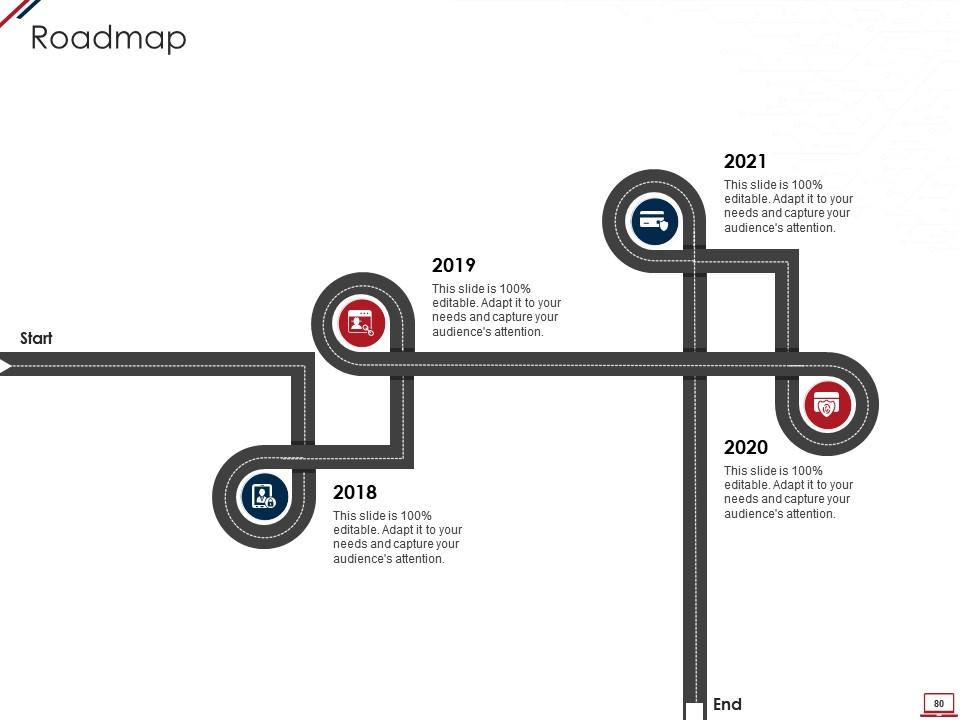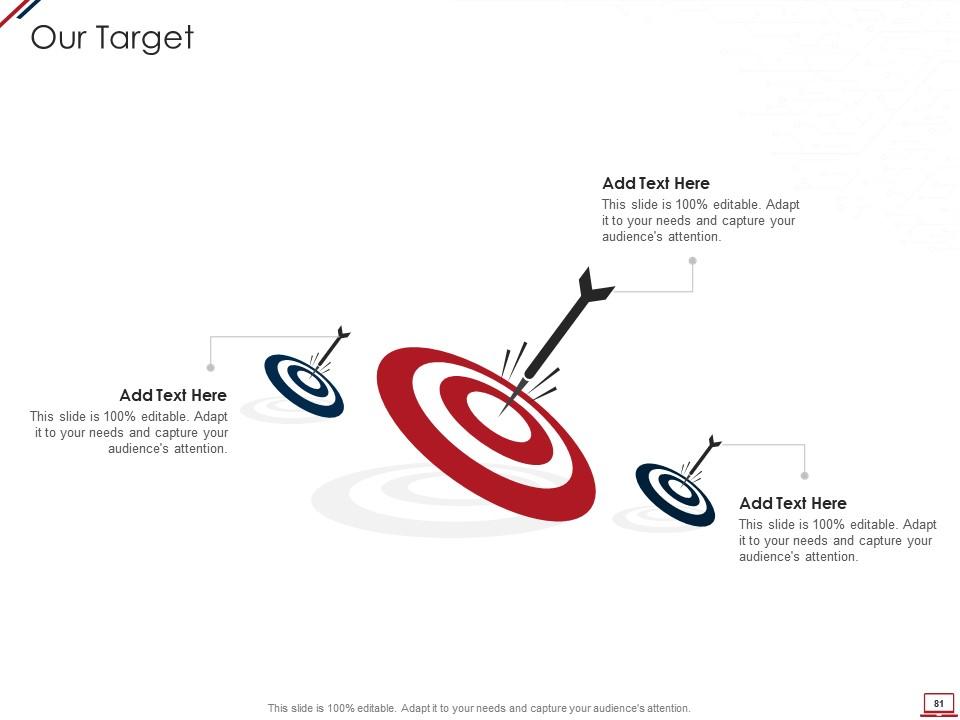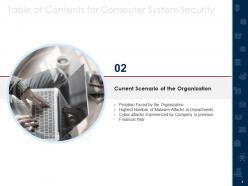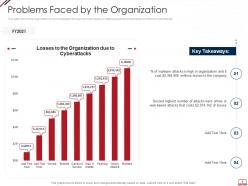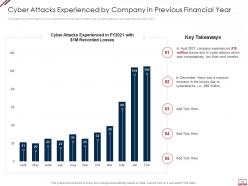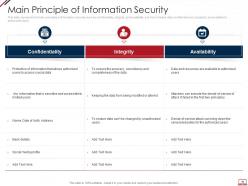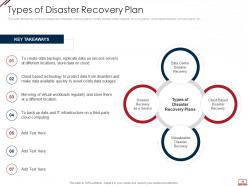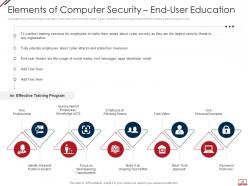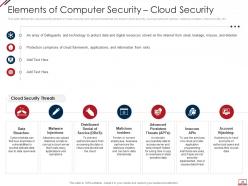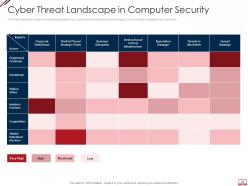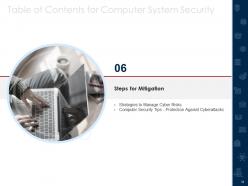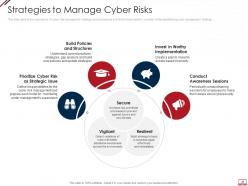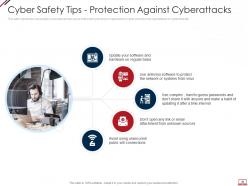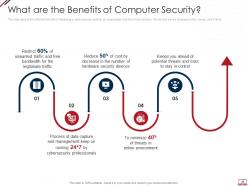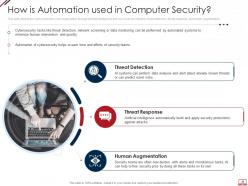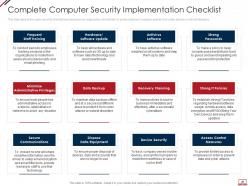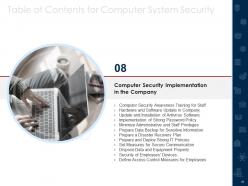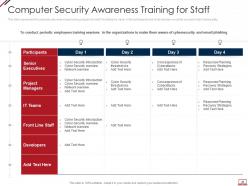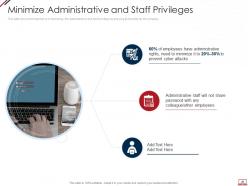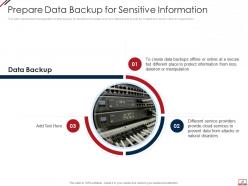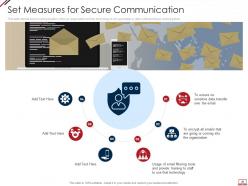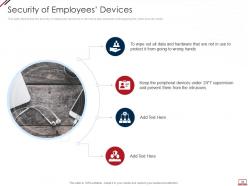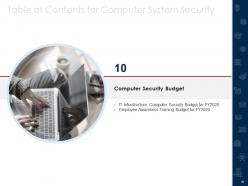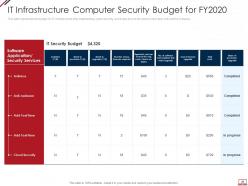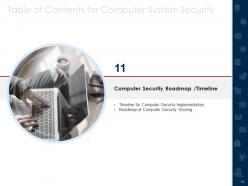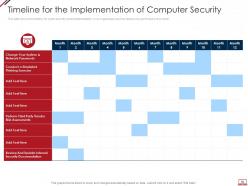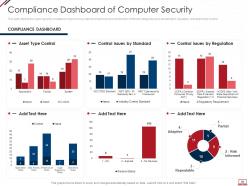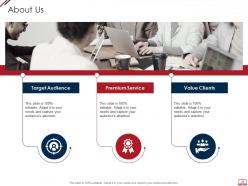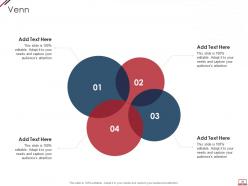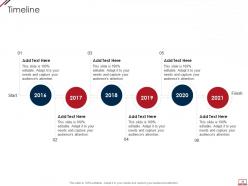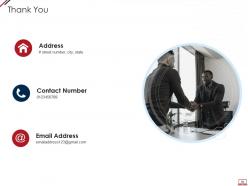Computer system security powerpoint presentation slides
Computer Security is the process of protecting electronic devices such as servers, mobile gadgets, data, electronic systems, and networks from cyber-attacks. Check out our competently designed template on Computer Security that illustrates important details about cybersecurity. Incorporating it, you can present and share details on the common threats against data and information systems and the process to identify the information that needs to be protected. This network security proposal will be helpful to throw light on the current scenario of the organization, the requirement of cybersecurity in different sectors, and its working. In addition, the computer security template contains the critical elements of cybersecurity, cyber risk identification and assessment, steps to mitigate those risks, and benefits of cybersecurity, along with automations role in cybersecurity. Further, this data security deck comes with a checklist to implement cybersecurity, a 30-60-90-day plan to manage cybersecurity, and the budget. The template also showcases a roadmap to monitor cybersecurity and a timeline to implement cybersecurity in the organization. Lastly, the computer security proposal shows the effects of cybersecurity implementation on the organization and dashboard for threat tracking in cybersecurity. Get access to the proposal and download it now.
- Google Slides is a new FREE Presentation software from Google.
- All our content is 100% compatible with Google Slides.
- Just download our designs, and upload them to Google Slides and they will work automatically.
- Amaze your audience with SlideTeam and Google Slides.
-
Want Changes to This PPT Slide? Check out our Presentation Design Services
- WideScreen Aspect ratio is becoming a very popular format. When you download this product, the downloaded ZIP will contain this product in both standard and widescreen format.
-

- Some older products that we have may only be in standard format, but they can easily be converted to widescreen.
- To do this, please open the SlideTeam product in Powerpoint, and go to
- Design ( On the top bar) -> Page Setup -> and select "On-screen Show (16:9)” in the drop down for "Slides Sized for".
- The slide or theme will change to widescreen, and all graphics will adjust automatically. You can similarly convert our content to any other desired screen aspect ratio.
Compatible With Google Slides

Get This In WideScreen
You must be logged in to download this presentation.
PowerPoint presentation slides
Deliver this complete deck to your team members and other collaborators. Encompassed with stylized slides presenting various concepts, this Computer System Security Powerpoint Presentation Slides is the best tool you can utilize. Personalize its content and graphics to make it unique and thought-provoking. All the eighty two slides are editable and modifiable, so feel free to adjust them to your business setting. The font, color, and other components also come in an editable format making this PPT design the best choice for your next presentation. So, download now.
People who downloaded this PowerPoint presentation also viewed the following :
Content of this Powerpoint Presentation
Slide 1: This slide displays title i.e. 'Computer Security' and your Company Name.
Slide 2: This slide presents agenda.
Slide 3: This slide exhibits table of contents.
Slide 4: This slide shows continued table of contents.
Slide 5: This slide illustrates title for 'Overview of computer security & its requirement'.
Slide 6: This slide defines the meaning of cyber security and how it helps to prevent data through different methods and techniques.
Slide 7: This slide depicts the requirement of cyber security in different sectors and the percentage of attacks experienced.
Slide 8: This slide highlights title for 'Current scenario of the organization'.
Slide 9: This slide shows the organization's current situation through the total losses (in millions)experienced because of different cyberattacks.
Slide 10: This slide shows the status of malware attacks on different departments such as IT, development, etc.
Slide 11: This slide shows the impact on the organization's financial condition due to cyber attacks in the past financial year 2021.
Slide 12: This slide presents title for 'key elements of computer security'.
Slide 13: This slide represents the different elements of cyber security such as application security, network security, etc.
Slide 14: This slide defines application security and categories of application threats and tools.
Slide 15: This slide depicts the information security methodology and core information security principles.
Slide 16: This slide represents the main principles of information security such as confidentiality, integrity, etc.
Slide 17: This slide represents the network security element of cyber security and different network security methods.
Slide 18: This slide depicts the disaster recovery plan in the cyber security model and what strategies an organization needs to adopt.
Slide 19: This slide defines the different categories of disaster recovery plans, namely as data center disaster recovery plans, etc.
Slide 20: This slide represents the detailed process of a disaster recovery plan, how it should work, etc.
Slide 21: This slide defines the operational security element of cyber security.
Slide 22: This slide depicts the main steps of operational security, such as describing sensitive information, etc.
Slide 23: This slide shows the end-user education within the cyber security model.
Slide 24: This slide defines the cloud security element of cyber security and various threats that can breach cloud security.
Slide 25: This slide represents the best practices for cloud security, such as the shared responsibility model, etc.
Slide 26: This slide depicts how tasks are performed under cloud security through the framework.
Slide 27: This slide displays title for 'Cyber risk identification'.
Slide 28: This slide depicts the main types of threats in cyber security, such as cybercrime, cyber terrorism, etc.
Slide 29: This slide depicts the categories of recent threats that recently emerged in the United States, United Kingdom, etc.
Slide 30: This slide depicts the standard methods used to threaten cyber-security by cybercriminals/attackers.
Slide 31: This slide presents title for 'Cyber risk assessment'.
Slide 32: This slide depicts the cyberattacks surface based on different property types.
Slide 33: This slide depicts the cyber threat landscape based on cybercriminal roles/actors and the impacts of successful cyberattacks on business.
Slide 34: This slide exhibits title for 'Steps for mitigation'.
Slide 35: This slide depicts the importance of cyber risk management strategy and procedures and factors that needs to be considered.
Slide 36: This slide represents various tips or procedures that can be followed to prevent an organization's cyber security from cyberattacks or cybercriminals.
Slide 37: This slide depicts title for 'Benefits, role, & implementation for computer security'.
Slide 38: This slide depicts the different benefits of deploying a cyber security model in an organization.
Slide 39: This slide depicts the cyber protection of an organization through artificial intelligence.
Slide 40: This slide depicts the cyber security checklist and measures an organization should take to protect data.
Slide 41: This slide highlights title for 'Computer security implementation'.
Slide 42: This slide represents the cybersecurity awareness training program for staff.
Slide 43: This slide depicts the hardware/software update measure under the cyber security model.
Slide 44: This slide depicts the benefits of using antivirus software in the organization.
Slide 45: This slide depicts the importance of having strong passwords for different online accounts.
Slide 46: This slide shows the importance of minimizing the administrative and staff privilege by showing its benefits for the company.
Slide 47: This slide represents the preparation of data backup for sensitive information and how data backup should be created and stored within an organization.
Slide 48: This slide depicts what factors will be considered while preparing a recovery planning of an organization to come back to business quickly and effectively.
Slide 49: This slide represents the value of having strong IT policies within an organization regarding software, hardware, passwords, and data transfer.
Slide 50: This slide depicts secure communication within an organization and the technology to encrypt emails or data while sending or receiving them.
Slide 51: This slide depicts the importance of disposal of the data and equipment that is not in use anymore.
Slide 52: This slide depicts that the security of employees’ hardware or devices is also essential while applying the cyber security model.
Slide 53: This slide represents how it is essential to minimize the rights/access of employees in an organization.
Slide 54: This slide displays title for 'Managing computer security'.
Slide 55: This slide depicts how the cyber security model will work in the first 30 days and the tasks the organization should focus on.
Slide 56: This slide represents the plan for 60 days after implementing the cyber security model in the organization.
Slide 57: This slide depicts the 90 days plan of the cyber security model in an organization and training compliance and methods used for communication.
Slide 58: This slide presents title for 'Computer security budget'.
Slide 59: This slide represents the budget for IT infrastructure after implementing cyber security.
Slide 60: This slide represents the organization's staff training budget through a graph covering trainer name, date, and capability levels.
Slide 61: This slide exhibits title for 'Computer security roadmap/timeline.
Slide 62: This slide shows the timeline for cyber security model implementation in an organization and the tasks to be performed every month.
Slide 63: This slide depicts the cyber security training roadmap. It also shows the plan and guidelines to conduct an effective training program.
Slide 64: This slide depicts title for 'Effect of implementing computer security in business'.
Slide 65: This slide depicts the impact of cyber security training on an organization.
Slide 66: This slide represents the current status of the cyber attacks in an organization after implementing the cyber security model.
Slide 67: This slide highlights title for 'KPIs/Dashboard for computer security tracking.
Slide 68: This slide depicts the dashboard for threat tracking in cyber security by covering monthly threat status, current risk status, etc.
Slide 69: This slide depicts the cyber security compliance report on how data and hardware are monitored in different categories.
Slide 70: This is the icons slide.
Slide 71: This slide presents title for additional slides.
Slide 72: This slide shows about your company, target audience and its client's values.
Slide 73: This slide shows details of team members like name, designation, etc.
Slide 74: This slide presents your company's vision, mission and goals.
Slide 75: This slide depicts posts for past experiences of clients.
Slide 76: This slide displays Venn.
Slide 77: This slide displays puzzle.
Slide 78: This slide highlights comparison of products based on selects.
Slide 79: This slide exhibits yearly timeline.
Slide 80: This slide shows roadmap.
Slide 81: This slide displays targets.
Slide 82: This is thank you slide & contains contact details of company like office address, phone no., etc.
Computer system security powerpoint presentation slides with all 82 slides:
Use our Computer System Security Powerpoint Presentation Slides to effectively help you save your valuable time. They are readymade to fit into any presentation structure.
FAQs
The categories of application threats in cyber security include injection flaws, broken authentication and session management, cross-site scripting, and insufficient logging and monitoring. The tools used to mitigate these threats include firewalls, intrusion detection and prevention systems, antivirus and antimalware software, and vulnerability scanners.
The core principles of information security include confidentiality, integrity, availability, authenticity, and non-repudiation. Confidentiality means protecting sensitive information from unauthorized access, integrity means ensuring the accuracy and completeness of data, availability means ensuring that authorized users have access to data when needed, authenticity means verifying the identity of users and data sources, and non-repudiation means ensuring that a user cannot deny the authenticity of data that they have sent or received.
The different network security methods used in cyber security include firewalls, intrusion detection and prevention systems, virtual private networks, network segmentation, and encryption. Firewalls are used to block unauthorized access to a network, intrusion detection and prevention systems are used to detect and prevent unauthorized access and attacks, virtual private networks are used to connect remote users to a network securely, network segmentation is used to divide a network into smaller, more secure subnetworks, and encryption is used to protect data transmitted over a network.
The different categories of disaster recovery plans in cyber security include data centre disaster recovery plans, cloud disaster recovery plans, and business continuity plans. Data centre disaster recovery plans to focus on recovering data and systems in the event of a disaster, cloud disaster recovery plans to focus on recovering data and systems hosted in the cloud, and business continuity plans focus on ensuring that critical business functions can continue in the event of a disaster.
The best practices for cloud security in cyber security include implementing a shared responsibility model, encrypting data in transit and at rest, implementing strong access controls, monitoring and logging activity, and performing regular backups and disaster recovery testing. The shared responsibility model ensures that both the cloud service provider and the customer are responsible for security, encryption protects data from unauthorized access.
-
The Designed Graphic are very professional and classic.
-
Excellent design and quick turnaround.
-
Editable templates with innovative design and color combination.
-
Great quality slides in rapid time.
-
Topic best represented with attractive design.


